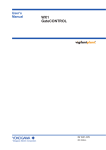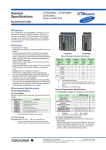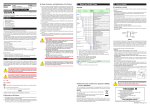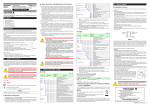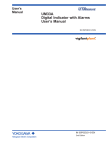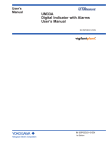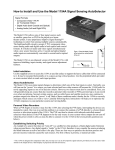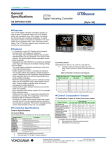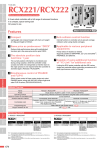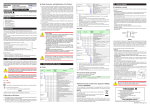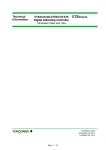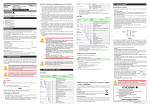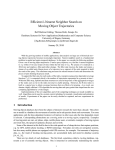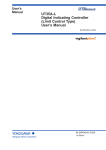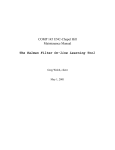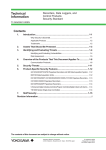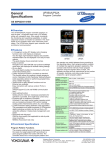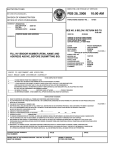Download UTAdvanced UP55A Program Controller Parameter Maps and Lists
Transcript
UTAdvanced UP55A Program Controller Parameter Maps and Lists TI 05P02C41-01EN ©Copyright July. 2011 1st Edition July. 2011 Page 1 / 25 UTAdvanced UP55A Introduction Brief Description of Sheets This sheet provides a brief description of the following sheets entitled "Names and Functions of Display Parts," "Operation and Program Parameter Map," "Setup Parameter Map," "List of Parameters," "Program Data Sheet," and "Example." "Names and Functions of Display Parts" This sheet describes the names and functions of display parts, function of parameter display level, meaning of parameter map symbol and numeric value, parameter display transition and setup operation, and display symbol list. "Operation Map (SGL_PRO)" This sheet describes the operation parameter map, which can be used as an operation guide. "Setup Map (SGL_PRO)" This sheet describes the setup parameter map, which can be used as an operation guide. "List of Parameters (SGL_PRO)" This sheet describes the setting range and initial value of operation parameters and setup parameters. There is a column for user settings. "Program Data Sheet" This sheet can be used for recording the setting value or creating the program pattern. "Example" This sheet describes an example of simply program pattern. Parameters in the sheets are displayed when the control mode is set to single loop control (CTLM=SGL) and the parameter display level is set to professional setting mode (LEVL=PRO). Some parameters are not displayed according to model and suffix codes. For details, refer to the User's Manual. Operation and Program Parameters: Parameters for setting the functions necessary for the operation and Parameters for creating the program pattern. Setup Parameters: Parameters for setting the basic functions of the controller. Notice The contents of this manual are subject to change without notice as a result of continuing improvements to the instrument’s performance and functions. Page 2 / 25 UTAdvanced UP55A Names and Functions of Display Parts UP55A Display Parts (1) PV display (white or red) (2) Group display (pattern number) (green) Description Displays PV. Displays an error code if an error occurs. Displays the scrolling guide in the Menu Display and Parameter Setting Display when the guide display ON/OFF is set to ON. 1 to 30 represent pattern numbers in the Operation Display. Displays a group number (1 to 8 or R) and terminal area (E1 to E4) in the Parameter Setting Display. (3) Symbol display (orange) Displays a parameter symbol. (4) Data display (orange) Displays a parameter setpoint and menu symbol. (5) Bar-graph display (event, alarm) (orange) Displays the event status and the segment position in the Operation Display. (Default values: Time event status, Alarm status) Displays control output value (OUT) and measured input value (PV). The data to be displayed can be set by the parameter. (6) Event indicator (orange) Lit when the PV events occur. Event displays can be set by the parameter. (7) Key navigation indicator (green) Lit or blinks when the Up/Down or Left/Right arrow key operation is possible. (8) Parameter display level indicator (green) Displays the setting conditions of the parameter display level function. Parameter display level EASY PRO Easy setting mode Lit Unlit Standard setting mode Unlit Unlit Professional setting mode Unlit Lit Program monitor (green) Displays the status of increment, constancy, and decrement of the program setpoint. : Lit when a program setpoint is increasing. : Lit when a program setpoint is constant. : Lit when a program setpoint is decreasing. Status indicator (green and red) Displays the operating conditions and control status. Display Description HLD Lit when in remote mode (HOLD). CAS Lit when in cascade mode (CAS). PRG Lit when in program operation mode (PRG). Lit while the Starting time of program operation (S.TM) is available. RST Lit when in reset mode (RST). MAN Lit when in manual mode (MAN). Blinks during auto-tuning. (11) Security indicator (red) Lit if a password is set. The setup parameter settings are locked. (12) Ladder operation indicator (green) Lit while the ladder program operation is executed. Loop 2 indicator (LP2 lamp) (green) Lit when the control mode is Cascade control. In the Operation Display, the LP2 lamp is lit while the Loop-2 data is displayed on Setpoint display. In the Parameter Setting Display, the LP2 lamp indicates the loop of displayed menu symbol or parameter symbol. The LP2 lamp is lit while the Loop-2 menu symbol or parameter symbol is displayed. No. in figure (9) (10) (13) Name Page 3 / 25 UP55A Key Parts Name No. in figure (1) DISPLAY key (2) PARAMETER key Description Used to switch the Operation Displays. Press the key in the Operation Display to switch the provided Operation Displays. Press the key in the Menu Display or Parameter Setting Display to return to the Operation Display. Hold down the key for 3 seconds to move to the Operation Parameter Setting Display. Hold down the key and the Left arrow key simultaneously for 3 seconds to move to the Setup Parameter Setting Display. Press the key in the Parameter Setting Display to return to the Menu Display. Press the key once to cancel the parameter setting (setpoint is blinking). (3) SET/ENTER key Up/Down/ Left/Right arrow keys SET/ENTER key Press the key in the Menu Display to move to the Parameter Setting Display of the Menu. Press the key in the Parameter Setting Display to transfer to the parameter setting mode (setpoint is blinking), and the parameter can be changed. Press the key during parameter setting mode to register the setpoint. Up/Down/Left/Right arrow keys Press the Left/Right arrow keys in the Menu Display to switch the Displays. Press the Up/Down/Left/Right arrow keys in the Parameter Setting Display to switch the Displays. Press the Up/Down arrow keys during parameter setting mode (setpoint is blinking) to change a setpoint. Press the Left/Right arrow keys during parameter setting mode (setpoint is blinking) to move between digits according to the parameter. (4) Light-loader interface It is the communication interface to the adapter cable when setting and storing parameters via PC. The LL50A Parameter Setting Software (sold separately) is required. RUN key RST key MODE key PTN key PTN key: Press the RUN key for 1 second while an operation display is shown starts the controller. RST key: Press the RST key for 1 second while an operation display is shown stops the controller. MODE key: Presents a display for switching between the HOLD, ADVANCE, PROG, RESET, LOCAL, REMOTE and AUTO/MAN. In order to change the operation mode, press the SET/ENTER key while the setpoint is blinking. PTN key: A program pattern number can be selected during the operation except the program pattern operation. (The program pattern number displayed on the Group display blinks.) When the PTN key is pressed while the program pattern number is blinking, the blinking stops. Users can assign functions to the key using parameters. (5) Page 4 / 25 Brief Description of Parameter Map The parameter display level is a function to control the parameters to be displayed. The factory setting is LEVL=STD. The control prevents unintentional change of the function. The parameter display level is just a function to hide the display so the set function works. Changing of parameter display level The parameters to be displayed can be controlled by changing the setting value for setup parameter LEVL. Parameter Display Level Setting value EASY EASY Symbol Corresponding parameters are displayedin all modes. STD Symbol Symbol Corresponding parameters are displayed only in Standard setting mode and Professional setting mode. Parameter display level indicators "EASY" and "PRO" are unlit in Standard setting mode. PRO PRO Symbol Symbol Symbol Corresponding parameters are displayed only in Professional setting mode. Meaning of Parameter Symbol and Numeric Value Numeric Value ↑ Symbol ↑ ↑ Symbol ↑ LP2: Program pattern-2 retransmission Group/Segment Parameter symbol Group E1: indicates the parameter in E1-terminal E2: indicates the parameter in E2-terminal E3: indicates the parameter in E3-terminal E4: indicates the parameter in E4-terminal 1 to 8, R: indicate the group numbers area area area area Display may be controlled according to the setting value of the setup parameter and operation status. Parameter Display Transition and Setup Operation To move to the Operation Parameter Setting Display Press the key for 3 seconds. To move to the Setup Parameter Setting Display + Press the key for 3 seconds. To move to the Operation Display If you cannot remember how to carry out an operation during setting, press the DISPLAY key once. This brings you to the display (Operation Display) that appears at power-on. <Operation for Setting> To select the parameter setting displayed as the initial value, press the Down arrow key to move to the next parameter. To change and set the parameter setting, press the SET/ENTER key to start the setpoint blinking. The blinking state allows you to make changes (setting mode). Use the Up/Down/Left/Right arrow keys to change the setpoint. Press the SET/ENTER key to register the setting. Page 5 / 25 The following operating procedure describes an example of setting alarm setpoint (A1) 1. Hold down the PARAMETER key for 3 seconds in the Operation Display to call up the [MODE] Menu Display. 2. Press the Right arrow key to display the [AL] Menu Display. 3. Press the SET/ENTER key to display the [A1] Parameter Setting Display. 4. Press the SET/ENTER key to blink the setpoint. 5. Press the Up or Down arrow key to change the setpoint. (Change the setpoint using the Up/Down arrow keys to increase and decrease the value and the Left/Right arrow keys to move between digits.) 6. Press the SET/ENTER key to register the setpoint (the setpoint stops blinking). 7. Press the PARAMETER key once to return to the Menu Display. Press the DISPLAY key once to return to the Operation Display. This completes the setting procedure. How to Cancel Parameter Setting To cancel parameter setting when a parameter is being set (setpoint is blinking), press the PARAMETER key once Page 6 / 25 How to Set Parameter Setpoint Numeric Value Setting Selection Data Setting Time (minute.second) Setting Page 7 / 25 List of Display Symbols The following shows the parameter symbols, menu symbols, alphanumeric of guide, and symbols which are displayed on the UP55A. Figure (common to all display area) PV display (14 segments): Alphabet Symbol display and Data display (11 segments): Alphabet Group display (7 segments): Alphabet PV display (14 segments): Symbol Page 8 / 25 UTAdvanced UP55A Operation and Program Parameter Map Parameters for setting the functions necessary for the operation. If you cannot remember how to carry out an operation during setting, press the DISPLAY key once. This brings you to the display (Operation Display) that appears at power-on Operation Display CS menu is displayed when the SELECT parameter has been registered. Press the key for 3 seconds. (END) * This parameter map is for the case that the control mode (CTLM) is set to single loop control (SGL). Some parameters are not displayed according to model and suffix codes. For details, refer to the User's Manual. Operation Mode SELECT Parameter Program Pattern Setting MODE CS PROG Local Setting Program Editing Alarm Setpoint Setting SP-related Setting Alarm Function Setting PV-related Setting PID Setting Tuning Zone Control P Parameter LOC EDIT AL SPS ALRM PVS PID TUNE ZONE PPAR ALL.S PTN.S USE.S CPY.S CPY.D CLR.P END A1 A2 A3 A4 A5 A6 A7 A8 END RMS RFL RT RBS SPT S.TM PNC END EHY1 EHY2 EHY3 EHY4 EHY5 EHY6 EHY7 EHY8 AL1 AL2 AL3 AL4 AL5 AL6 AL7 AL8 VT1 VT2 VT3 VT4 VT5 VT6 VT7 VT8 HY1 HY2 HY3 HY4 HY5 HY6 HY7 HY8 DYN1 DYN2 DYN3 DYN4 DYN5 DYN6 DYN7 DYN8 DYF1 DYF2 DYF3 DYF4 DYF5 DYF6 DYF7 DYF8 AMD END BS FL END P I D OH OL MR HYS HY.UP HY.LO DR Pc Ic Dc OHc OLc HYSc DB PO POc END SC AT.TY AT.OH AT.OL AT.BS GW GG AR OPR OLMT MPON MPO1 MPO2 MPO3 MPO4 MPO5 END RP1 RP2 RP3 RP4 RP5 RP6 RP7 RHY RDV END P01 P02 P03 P04 P05 P06 P07 P08 P09 P10 END 10-segment Linearizer-2 Setting 10-segment Linearizer-3 Setting 10-segment Linearizer-4 Setting The parameter in PROG is displayed in the PV Display. 0 1 SSP LP2 1 SSP 1 STC 1 WT.SW1 1 WZ.UP1 1 WZ.LO1 1 WT.TM1 1 WT.SW2 1 WZ.UP2 1 WZ.LO2 1 WT.TM2 WT.SW5 WZ.UP5 WZ.LO5 WT.TM5 R.CYCL R.STRT R.END END ↑ 1 1 1 1 1 1 1 TSP LP2 TSP TIME TM.RT S.PID JC PV.TY1 PV.EV1 99 99 99 99 99 99 99 99 PV.TY8 PV.EV8 TME1 T.ON1 T.OF1 99 ······ TME16 T.ON16 T.OF16 END 99 99 99 99 99 99 TSP LP2 TSP TIME TM.RT S.PID JC PV.TY1 PV.EV1 PV.TY8 PV.EV8 TME1 T.ON1 T.OF1 LP2 TME16 T.ON16 99 T.OF16 END 99 Corresponding parameters are displayedin all modes. Symbol Corresponding parameters are displayed only in Standard setting mode and Professional setting mode. Parameter display level indicators "EASY" and "PRO" are unlit in Standard setting mode. Symbol ↑ ↑ LSP LSP L.PID L.TY1 L.EV1 L.TY2 L.EV2 L.TY3 L.EV3 L.TY4 L.EV4 L.TY5 L.EV5 L.TY6 L.EV6 L.TY7 L.EV7 L.TY8 L.EV8 END 99 Symbol Symbol Numeric Value 1 to 99 … SEGNO. 1 to 30 … PTNO. … CS10 CS11 CS12 CS13 CS14 CS15 CS16 CS17 CS18 CS19 END … HOLD ADV MODE A.M PTNO. SST P.FWD AT PID END … SET/ENTER key Corresponding parameters are displayed only in Professional setting mode. Symbol ↑ Display may be controlled according to the setting value of the setup parameter and operation status. LP2: Program pattern-2 retransmission Group/Segment Parameter symbol To move to the Setup Parameter Setting Display 1 1 1 1 1 1 1 1 1 1 1 1 1 1 1 1 1 1 1 P I D OH OL MR HYS HY.UP HY.LO DR Pc Ic Dc OHc OLc HYSc DB PO POc END 8 8 8 8 8 8 8 8 8 ······ 8 8 8 8 8 8 8 8 8 8 R R R R R R ··· R R R R R R R R R R 2 PYS2 3 PYS3 4 PYS4 1 PYS A1 B1 A2 B2 A3 B3 A4 B4 A5 B5 A6 B6 A7 B7 A8 B8 A9 B9 A10 B10 A11 B11 PMD END 2 PYS A1 B1 A2 B2 A3 B3 A4 B4 A5 B5 A6 B6 A7 B7 A8 B8 A9 B9 A10 B10 A11 B11 PMD END 3 PYS A1 B1 A2 B2 A3 B3 A4 B4 A5 B5 A6 B6 A7 B7 A8 B8 A9 B9 A10 B10 A11 B11 PMD END 4 PYS A1 B1 A2 B2 A3 B3 A4 B4 A5 B5 A6 B6 A7 B7 A8 B8 A9 B9 A10 B10 A11 B11 PMD END 1 1 1 1 1 1 1 1 1 1 1 1 1 1 1 1 1 1 1 1 Page 9 / 25 R PYS1 1 Press the key for 3 seconds. R 1 1 To move to the Operation Parameter Setting Display R 10-segment Linearizer-1 Setting 1 + Press the key for 3 seconds. P I D OH OL MR HYS HY.UP HY.LO DR Pc Ic Dc OHc OLc HYSc DB PO POc END 2 2 2 2 2 2 2 2 2 2 2 2 2 2 2 2 2 2 2 2 2 2 2 3 3 3 3 3 3 3 3 3 3 3 3 3 3 3 3 3 3 3 3 3 3 3 4 4 4 4 4 4 4 4 4 4 4 4 4 4 4 4 4 4 4 4 4 4 4 END (MODE) UTAdvanced UP55A Setup Parameter Map Parameters for setting the basic functions of the controller * This parameter map is for the case that the control mode (CTLM) is set to single loop control (SGL). Some parameters are not displayed according to model and suffix codes. For details, refer to the User's Manual. Operation Display If you cannot remember how to carry out an operation during setting, press the DISPLAY key once. This brings you to the display (Operation Display) that appears at power-on. + Press the key for 3 seconds. PASS (END) SET/ENTER key Displayed when a password has been PV Input Setting CTL PV E1 RSP E2 AIN2 CTLM CNT ALG ALNO. ZON SEG.T TMU PT2.G SMP END IN UNIT RH RL SDP SH SL BSL RJC ERJC A.BS A.FL A.SR A.LC END E1 IN UNIT RH RL SDP SH SL BSL RJC ERJC RTD.S A.BS A.FL A.SR A.LC DI6.D END E2 IN UNIT RH RL SDP SH SL BSL A.BS A.FL A.SR A.LC DI6.D END RSP Setting E1 E1 E1 E1 E1 E1 E1 E1 E1 E1 E1 E1 E1 E1 E1 Symbol Symbol ↑ Group/Segment ↑ Output Setting Heater Break Alarm Setting E4 AIN4 MPV OUT HBA E3 R485 E4 R485 E3 ETHR E3 PROF E3 DNET E4 IN UNIT RH RL SDP SH SL BSL A.BS A.FL A.SR A.LC DI6.D END P.UNI P.DP P.RH P.RL SPH SPL END OT CT CTc V.AT V.RS V.L V.H TR.T V.MOD RTS RTH RTL O1RS O1RH O1RL O2RS O2RH O2RL OU.H OU.L OU2.H OU2.L RET.H RET.L OU.A OU2.A RET.A END HB1.S HB2.S HB1 HB2 CT1.T CT2.T HDN1 HDN2 HDF1 HDF2 HB1.D HB2.D END E3 PSL BPS PRI STP DLN ADR RP.T END E4 PSL BPS PRI STP DLN ADR RP.T END E3 HSR BPS PRI IP1 IP2 IP3 IP4 SM1 SM2 SM3 SM4 DG1 DG2 DG3 DG4 PRT IPAR 1.IP1 1.IP2 1.IP3 1.IP4 2.IP1 2.IP2 2.IP3 2.IP4 ESW END E3 BR ADR BPS FILE SCAN END E3 BR ADR BPS FILE SCAN END E2 E2 E2 E2 E2 E2 E2 E2 E2 E2 DI Setting (E2 terminal area) DI Setting (E3 terminal area) E4 E4 E4 E4 E4 E4 E4 E4 E4 E4 E4 E4 Corresponding parameters are displayed only in Standard setting mode and Professional setting mode. Parameter display level indicators "EASY" and "PRO" are unlit in Standard setting mode Symbol ↑ E2 PROFIBUSDP Communicat ion Setting Input Range/SP Limiter Setting Corresponding parameters are displayedin all modes. Symbol Numeric Value E2 RS-485 Communicat ion Setting (E4 terminal area) RS-485 Communicat ion Setting (E3 terminal area) AIN4 Aux. Analog Input Setting AIN2 Aux. Analog Input Setting Control Function Setting Corresponding parameters are displayed only in Professional setting mode. E3 E3 E3 E3 E3 E3 E4 E4 E4 E4 E4 E4 Ethernet Communicat ion Setting E3 E3 E3 E3 E3 E3 E3 E3 E3 E3 E3 E3 E3 E3 E3 E3 E3 E3 E3 E3 E3 E3 E3 E3 E3 E3 E3 E3 E3 DeviceNet Communicat ion Setting E3 E3 E3 E3 CC-Link Communicat ion Setting Key Action Setting Display Function Setting SELECT Display Setting E3 CC-L KEY DISP CSEL E3 BR ADR BPS FILE SCAN END RUN RST PTN MODE END PCMD PCH PCL PTSL BAR1 BAR2 BDV EV1 EV2 EV3 EV4 EV5 EV6 EV7 EV8 PV.D SP.D STS.D SPD GUID HOME ECO BRI B.PVW B.PVR B.SP B.BAR B.STS D.CYC OP.JP MLSD END CS1 CS2 CS3 CS4 CS5 CS10 CS11 CS12 CS13 CS14 CS15 CS16 CS17 CS18 CS19 END E3 E3 E3 E3 Symbol ↑ LP2: Program pattern-2 retransmission Parameter symbol SET/ENTER key Key Lock Setting Menu Lock Setting DI Function Registration DI Function Numbering DI1-DI3 Contact Type Setting KLOC MLOC DI.SL DI.NU DI.D E1 DI.D E2 DI.D E3 DI.D CTL PV RSP AIN2 AIN4 MPV MPV OUT HBA R485 R485 ETHR PROF DNET CC-L KEY DISP CSEL KLOC DI.SL DI.NU DI.D DI.D DI.D DI.D DI.D ALM DO DO DO DO I/O SYS INIT VER PRG RST LOC REM P/R P/H P/L HOLD ADV WAIT S.HLD A/M AT LAT LCD PVRW MG1 MG2 MG3 MG4 END PT.B0 PT.B1 PT.B2 PT.B3 PT.B4 PT.B5 PN.B0 PN.B1 PN.B2 PN.B3 MP.B0 MP.B1 MP.B2 PT.BC PN.BC MP.BC END DI1.D DI2.D DI3.D END E1 DI1.D DI2.D DI3.D DI4.D DI5.D END E2 DI1.D DI2.D DI3.D DI4.D DI5.D END E3 DI1.D DI2.D DI3.D DI4.D DI5.D END U.SP U.SP U.TSP U.TSP U.TM U.OUT U.OUT U.HCO U.VP U.MV U.PID U.PID U.SEG U.RCY U.PTN U.AL U.AL U.HC U.PV1 U.PV2 U.PV U.RSP U.AI2 U.AI4 COM.W DATA RUN RST PTN MODE END LP2 E1 LP2 E2 E4 LP2 E3 E4 LP2 E3 E3 E3 E3 LP2 LP2 E1 E2 E3 E4 E1 E2 E3 E4 LP2 DI Setting (E1 terminal area) E1 E1 E1 E1 E2 E2 E2 E2 E3 E3 E3 E3 DI Setting (E4 terminal area) AL1-AL3 Function Registration E4 DI.D ALM E1 DO E2 DO E3 DO E4 DI1.D DI2.D DI3.D DI4.D DI5.D END AL1.S AL2.S AL3.S OR.S OR2.S AL1.D AL2.D AL3.D OR.D OR2.D END E1 DO1.S DO2.S DO3.S DO4.S DO5.S DO1.D DO2.D DO3.D DO4.D DO5.D END E2 DO1.S DO2.S DO3.S DO4.S DO5.S DO1.D DO2.D DO3.D DO4.D DO5.D END E3 DO1.S DO2.S DO3.S DO4.S DO5.S DO1.D DO2.D DO3.D DO4.D DO5.D END E4 E4 E4 E4 DO Setting (E1 terminal area) E1 E1 E1 E1 E1 E1 E1 E1 E1 DO Setting (E2 terminal area) E2 E2 E2 E2 E2 E2 E2 E2 E2 DO Setting (E3 terminal area) E3 E3 E3 E3 E3 E3 E3 E3 E3 DO Setting (E4 terminal area) I/O Display System Setting Initialization Error and Version Confirmation Parameter Display Level E4 DO I/O SYS INIT VER LVL E4 DO1.S DO2.S DO3.S DO4.S DO5.S DO1.D DO2.D DO3.D DO4.D DO5.D END KEY X000 X100 X200 X300 X400 Y000 Y100 Y200 Y300 Y400 END R.MD R.TM EPO C.GRN FREQ QSM LANG PASS SMEC END U.DEF F.DEF P.DEF END PA.ER OP.ER AD1.E AD2.E PV1.E PV2.E LA.ER MCU DCU ECU1 ECU2 ECU3 ECU4 PARA H.VER SER1 SER2 MAC1 MAC2 MAC3 END LEVL E4 E4 E4 E4 E4 E4 E4 E4 E4 E1 E2 E3 E4 E1 E2 E3 E4 E1 E2 E3 E4 1 2 3 4 LVL MODE CS PROG LOC EDIT AL SPS ALRM PVS PID TUNE ZONE PPAR PYS1 PYS2 PYS3 PYS4 END E3 E3 E3 Page 10 / 25 LP2 END (CTL) UTAdvanced UP55A List of Parameters * This parameter lists are for the case that the control mode (CTLM) is set to single loop control (SGL). Some parameters are not displayed according to model and suffix codes. For details, refer to the User's Manual. Operation and Program Parameters Operation Mode Menu MODE Symbol Name Display level Setting range Initial value User setting Initial value User setting ON: Pause OFF: Cancel release (Program operation restart) OFF Display during program operation. OFF: Display during program operation. OFF Set as “ADV = ON” to advance from the current segment to the next segment. HOLD Pause/cancel release of program operation EASY ADV Advance of segment EASY MODE Operation mode EASY RESET: Stop of program operation PROG: Start of program operation LOCAL: Start of local-mode operation REM: Start of remote-mode operation RESET A.M AUTO/MAN switch EASY AUTO: Automatic mode MAN: Manual mode MAN PTNO. Program pattern number selection EASY 0: Not select program pattern 1 to 30 0 1 1 SST Start-of-program segment number EASY 1 to 99 The setting value returns to “1” when the program operation (PROG) changes into RESET, LOCAL, or REM. P.FWD Fast-forwarding of program operation EASY 1: Normal, 2: Twice, 5: Five times, 10: Ten times, 20: Twenty times * Use this function when checking the program pattern setting. Only Segment time and Time event can be faster. * The operation returns to the normal speed after fast-forwarding. AT Auto-tuning switch EASY PID PID number EASY OFF: Disable 1 to 8: Perform auto-tuning. Tuning result is stored in the specified numbered PID. R: Tuning result is stored in the PID for reference deviation. The PID group number being selected is displayed. (display only) 1 to 8, R: PID group for reference deviation OFF 1 SELECT Parameter Menu CS Symbol Name Display level Setting range CS10 SELECT parameter 10 EASY - CS11 SELECT parameter 11 EASY - CS12 SELECT parameter 12 EASY - CS13 SELECT parameter 13 EASY CS14 SELECT parameter 14 EASY CS15 SELECT parameter 15 EASY CS16 SELECT parameter 16 EASY - CS17 SELECT parameter 17 EASY - CS18 SELECT parameter 18 EASY - CS19 SELECT parameter 19 EASY - - Setting range of a registered parameter. See User's Manual. - Program pattern-2 retransmission (PT2.G=ON) Program Pattern Setting Menu PROG> SEGNO. Symbol SSP Name Starting target setpoint Display level Setting range Initial value User setting EASY 0.0 to 100.0% of PV input range (EU) (Setting range: P.RL to P.RH) P.RL See Sheet"Program Data Sheet" SSP See Sheet"Program Data Sheet" OFF See Sheet"Program Data Sheet" 0.5% of PV input range See Sheet"Program Data Sheet" 0.5% of PV input range See Sheet"Program Data Sheet" STC Start code EASY SSP: Program operation begins with the starting target setpoint. RAMP: Ramp-prioritized PV start TIME: Time-prioritized PV start LSP: Local-mode start RSP: Remote-mode start * STC=TIME cannot be selected when the parameter SEG.T is TM.RT. WT.SW1 Wait function ON/OFF 1 STD OFF: Disable ON: Enable WZ.UP1 Upper-side wait zone 1 STD WZ.LO1 Lower-side wait zone 1 STD WT.TM1 Wait time 1 STD OFF: No function 0.00 to 999.59 (“hour.minute” or “minute.second”) * Available only for the wait time at the segment switching. * Use the parameter TMU to set the time unit. (Common in the instrument.) OFF See Sheet"Program Data Sheet" WT.SW2 Wait function ON/OFF 2 STD Same as SW1. OFF See Sheet"Program Data Sheet" WZ.UP2 Upper-side wait zone 2 STD 0.5% of PV input range See Sheet"Program Data Sheet" WZ.LO2 Lower-side wait zone 2 STD 0.5% of PV input range See Sheet"Program Data Sheet" WT.TM2 Wait time 2 STD Same as TM1. OFF See Sheet"Program Data Sheet" WT.SW3 Wait function ON/OFF 3 STD Same as SW1. OFF See Sheet"Program Data Sheet" WZ.UP3 Upper-side wait zone 3 STD 0.5% of PV input range See Sheet"Program Data Sheet" WZ.LO3 Lower-side wait zone 3 STD 0.5% of PV input range See Sheet"Program Data Sheet" WT.TM3 Wait time 3 STD Same as TM1. OFF See Sheet"Program Data Sheet" WT.SW4 Wait function ON/OFF 4 STD Same as SW1. OFF See Sheet"Program Data Sheet" WZ.UP4 Upper-side wait zone 4 STD 0.5% of PV input range See Sheet"Program Data Sheet" WZ.LO4 Lower-side wait zone 4 STD 0.5% of PV input range See Sheet"Program Data Sheet" WT.TM4 Wait time 4 STD Same as TM1. OFF See Sheet"Program Data Sheet" WT.SW5 Wait function ON/OFF 5 STD Same as SW1. OFF See Sheet"Program Data Sheet" WZ.UP5 Upper-side wait zone 5 STD 0.5% of PV input range See Sheet"Program Data Sheet" WZ.LO5 Lower-side wait zone 5 STD 0.5% of PV input range See Sheet"Program Data Sheet" WT.TM5 Wait time 5 STD Same as TM1. OFF See Sheet"Program Data Sheet" R.CYCL Number of repeat cycles STD 0 to 999, CONT (The controller indefinitely repeats the segment specified by the R.STRT and R.END parameters.) 0 See Sheet"Program Data Sheet" R.STRT Repeat cycle start segment number STD 1 See Sheet"Program Data Sheet" 1 See Sheet"Program Data Sheet" 0.0 to 10.0% of PV input range (EU) Same as WZ.UP1 and WZ.LO1. Same as WZ.UP1 and WZ.LO1. Same as WZ.UP1 and WZ.LO1. Same as WZ.UP1 and WZ.LO1. 1 to 99 1 ≤ R.STRT ≤ R.END ≤ 99 R.END Repeat cycle end segment number STD When the program pattern-2 retransmission is selected (PT2.G=ON), the second loop is also displayed for the parameter SSP. (LP2 lamp is lit.) Page 11 / 25 User setting See Sheet"Program Data Sheet" Program pattern-2 retransmission (PT2.G=ON) Program Pattern Setting Menu PROG> PTNO. Symbol TSP Name Final target setpoint Display level EASY Setting range Initial value 0.0 to 100.0% of PV input range (EU) (Setting range: P.RL to P.RH) -: Unregistered 0.00 to 999.59 (“hour.minute” or “minute.second”) * Setting available for the parameter SEG.T=TIME. * Use the parameter TMU to set the time unit. (Common in the instrument.) * If the setting is 0.00, TSP changes in stepwise after one control period. -: Unregistered Ramp: 0.0 to 100.0% of PV input range span (EUS) / 1 hour or 1 minute Soak: 0.00 to 999.59 (“hour.minute” or “minute.second”) * Setting available for the parameter SEG.T=TM.RT. * Use the parameter TMU to set the time unit. (Common in the instrument.) Per 1 hour: TMU=HH.MM, Per 1 minute: TMU=MM.SS * If it is set to 0.0% of the input range span, or the segment time 0.00, the program moves to the next segment after one control period. User setting P.RL See Sheet"Program Data Sheet" - See Sheet"Program Data Sheet" - See Sheet"Program Data Sheet" 1 See Sheet"Program Data Sheet" TIME Segment time setting EASY TM.RT Segment ramp-rate setting EASY S.PID Segment PID number selection EASY 1 to 8 * PID number can be set when the parameter “ZON = 0.” STD CONT: Switching for continuation HOLD: Hold-on switching (the controller holds the end-of-segment setpoint when the segment is completed, to perform control). LOCAL: Local-mode switching (the controller switches to a local setpoint when the segment is completed). REM: Remote-mode switching (the controller switches to a remote setpoint when the segment is completed). W.SW1 to W.SW5: Wait during switching between segments. CONT W.IV1 to W.IV5: Wait within a segment interval. W.SL1 to W.SL5: Segment switching (the controller switches to a local setpoint when the segment is completed after release.) (5 groups) W.SR1 to W.SR5: Segment switching (the controller switches to a remote setpoint when the segment is completed after release.) (5 groups) PLK.1 to PLK.30: Linked to patterns 1 to 30. INS.: Allows a segment to be added to the end of a specified segment. DEL.: Allows a specified segment to be deleted. See Sheet"Program Data Sheet" OFF See Sheet"Program Data Sheet" JC Junction code PV.TY1~ PV.TY8 PV event-1 to -8 type STD OFF: Disable (Energized) 1: PV high limit, 2: PV low limit, 3: SP high limit, 4: SP low limit, 5: Deviation high limit, 6: Deviation low limit, 7: Deviation high and low limits, 8: Deviation within high and low limits, 9: Target SP high limit, 10: Target SP low limit, 11: Target SP deviation high limit, 12: Target SP deviation low limit, 13: Target SP deviation high and low limits, 14: Target SP deviation within high and low limits, 15: OUT high limit, 16: OUT low limit, 17: Cooling-side OUT high limit, 18: Cooling-side OUT low limit * Add 100 for "de-energized". For example, when the PV high limit is deenergized, the setting is 101. PV.EV1~ PV.EV8 PV event-1 to -8 setpoint STD Set a display value of setpoint of PV alarm, SP alarm, deviation alarm, or output alarm. -19999 to 30000 (Set a value within the input range.) Decimal point position depends on the input type. 0 See Sheet"Program Data Sheet" TME1~TME16 Start condition of time event 1 to 16 STD ON: Start ON state OFF: Start OFF state OFF See Sheet"Program Data Sheet" - See Sheet"Program Data Sheet" - See Sheet"Program Data Sheet" T.ON1~T.ON16 On time of time event 1 to 16 STD T.OF1~T.OF16 Off time of time event 1 to 16 STD -: Unregistered 0.01 to 999.59 (“hour.minute” or “minute.second”) * Available only within the segment time. * OFF when the operation mode is changed to the mode except the program operation. * Use the parameter TMU to set the time unit. (Common in the instrument.) Program pattern-2 retransmission (PT2.G=ON) Local Setting Menu LOC Symbol LSP Name Local target setpoint L.PID PID number selection for local mode operation Display level Setting range EASY 0.0 to 100.0% of PV input range (EU) (Setting range: P.RL to P.RH) P.RL EASY Set a PID group number to use. 1 to 8 * Available only for the L.PID when ZON = 0 or 5. * If set to “Local PID selection,” local PID is selected irrespective of the operation modes. 1 L.TY1 Local event-1 type STD L.EV1 Local event-1 setpoint STD STD OFF: Disable (Energized) 1: PV high limit, 2: PV low limit, 3: SP high limit, 4: SP low limit, 5: Deviation high limit, 6: Deviation low limit, 7: Deviation high and low limits, 8: Deviation within high and low limits, 9: Target SP high limit, 10: Target SP low limit, 11: Target SP deviation high limit, 12: Target SP deviation low limit, 13: Target SP deviation high and low limits, 14: Target SP deviation within high and low limits, 15: OUT high limit, 16: OUT low limit, 17: Cooling-side OUT high limit, 18: Cooling-side OUT low limit * Add 100 for "de-energized". For example, when the PV high limit is deenergized, the setting is 101. Set a display value of setpoint of PV alarm, SP alarm, deviation alarm, or output alarm. -19999 to 30000 (Set a value within the input range.) Decimal point position depends on the input type Same as L.TY1 Initial value User setting Initial value User setting Initial value User setting OFF 0 L.TY2 Local event-2 type L.EV2 Local event-2 setpoint STD Same as L.EV1 0 L.TY3 Local event-3 type STD Same as L.TY1 OFF OFF L.EV3 Local event-3 setpoint STD Same as L.EV1 0 OFF L.TY4 Local event-4 type STD Same as L.TY1 L.EV4 Local event-4 setpoint STD Same as L.EV1 0 L.TY5 Local event-5 type STD Same as L.TY1 OFF L.EV5 Local event-5 setpoint STD Same as L.EV1 0 L.TY6 Local event-6 type STD Same as L.TY1 OFF L.EV6 Local event-6 setpoint STD Same as L.EV1 0 L.TY7 Local event-7 type STD Same as L.TY1 OFF L.EV7 Local event-7 setpoint STD Same as L.EV1 0 L.TY8 Local event-8 type STD Same as L.TY1 OFF L.EV8 Local event-8 setpoint STD Same as L.EV1 0 Program Editing Menu EDIT Symbol Name Display level Setting range ALL.S Number of remaining unused segments PRO 0 to 300 (Display only) 300 PTN.S Pattern number designation for comfirming number of segments PRO Specify the numbers of program pattern to display in parameter USE.S. 1 to 30 0 - USE.S Number of segments within a pattern PRO Can be displayed when the parameter number specify in parameter PTN.S. (Display only) 0: disable 1 to 99 CPY.S Source-of-copying pattern number designation PRO Specify the number of the sourceof-copying program pattern. (1 to 30) 0 CPY.D Target-of-copying pattern number designation PRO Specify the target-of-copying program pattern. (1 to 30) 0 CLR.P Program pattern clearance PRO Specify the number of the program pattern to be cleared. (1 to 30) 0 Alarm Setpoint Setting Menu AL User setting See Sheet"Program Data Sheet" Symbol Name Display level Setting range A1 Alarm-1 setpoint EASY 0 A2 Alarm-2 setpoint EASY A3 Alarm-3 setpoint EASY A4 Alarm-4 setpoint EASY A5 Alarm-5 setpoint EASY A6 Alarm-6 setpoint EASY A7 Alarm-7 setpoint EASY 0 A8 Alarm-8 setpoint EASY 0 These alarms work irrespective of the operation mode. Set a display value of setpoint of PV alarm, SP alarm, deviation alarm, output alarm, or velocity alarm. -19999 to 30000 (Set a value within the input range.) Decimal point position depends on the input type. 0 0 0 0 0 Page 12 / 25 User setting SP-related Setting Menu SPS Symbol Name Display level Setting range Initial value RMS Remote input method STD RSP: Via remote (aux. analog) input COM: Via communication RSP RFL Remote input filter STD OFF, 1 to 120 s OFF RT Remote input ratio STD 0.001 to 9.999 1.000 STD -100.0 to 100.0% of PV input range span (EUS) 0.0 % of PV input range span STD OFF, ON Tracking is performed when the mode changes from Program or Remote to Local. (The local setpoint keeps track of the remote setpoint.) OFF RBS Remote input bias SPT SP tracking selection S.TM Starting time of program operation STD 0.00 to 999.59 (“hour.minute” or “minute.second” (common use of instrument) 0.00 * Use the parameter TMU to set the time unit. PNC Program pattern number clearance STD OFF: Not cleared. ON: Cleared. (Set the program No. before restart program operation) * The controller resets (clears) the program pattern number on the operating display to “0” at the end of program operation. User setting OFF Alarm Function Setting Menu ALRM Symbol Name Display level Setting range Initial value EHY1 Event-1 hysteresis STD EHY2 Event-2 hysteresis STD EHY3 Event-3 hysteresis STD EHY4 Event-4 hysteresis STD EHY5 Event-5 hysteresis STD EHY6 Event-6 hysteresis STD EHY7 Event-7 hysteresis STD 0.5% EHY8 Event-8 hysteresis STD 0.5% AL1 Alarm-1 type EASY AL2 Alarm-2 type EASY AL3 Alarm-3 type EASY AL4 Alarm-4 type EASY AL5 Alarm-5 type EASY AL6 Alarm-6 type EASY AL7 Alarm-7 type EASY AL8 Alarm-8 type EASY VT1 PV velocity alarm time setpoint 1 EASY 1.00 VT2 PV velocity alarm time setpoint 2 EASY 1.00 VT3 PV velocity alarm time setpoint 3 EASY VT4 PV velocity alarm time setpoint 4 EASY VT5 PV velocity alarm time setpoint 5 EASY VT6 PV velocity alarm time setpoint 6 EASY 1.00 VT7 PV velocity alarm time setpoint 7 EASY 1.00 VT8 PV velocity alarm time setpoint 8 EASY 1.00 HY1 Alarm-1 hysteresis EASY HY2 Alarm-2 hysteresis EASY HY3 Alarm-3 hysteresis EASY HY4 Alarm-4 hysteresis EASY HY5 Alarm-5 hysteresis EASY HY6 Alarm-6 hysteresis EASY HY7 Alarm-7 hysteresis EASY 10 HY8 Alarm-8 hysteresis EASY 10 DYN1 Alarm-1 On-delay timer STD 0.00 DYN2 Alarm-2 On-delay timer STD 0.00 DYN3 Alarm-3 On-delay timer STD DYN4 Alarm-4 On-delay timer STD DYN5 Alarm-5 On-delay timer STD DYN6 Alarm-6 On-delay timer STD 0.00 DYN7 Alarm-7 On-delay timer STD 0.00 DYN8 Alarm-8 On-delay timer STD 0.00 DYF1 Alarm-1 Off-delay timer PRO 0.00 DYF2 Alarm-2 Off-delay timer PRO 0.00 DYF3 Alarm-3 Off-delay timer PRO DYF4 Alarm-4 Off-delay timer PRO DYF5 Alarm-5 Off-delay timer PRO DYF6 Alarm-6 Off-delay timer PRO 0.00 DYF7 Alarm-7 Off-delay timer PRO 0.00 DYF8 Alarm-8 Off-delay timer PRO AMD Alarm mode STD User setting 0.5% 0.5% The hysteresis setpoint of PV event or Local event is set to the parcentage of 0.0 to 100.0%. The setting value (%) is for the PV input range span or output span. These alarms work irrespective of the operation mode. Set a 5-digit value in the following order. [Alarm type: 2 digits (see below)] + [Without (0) or With (1) Stand-by action] + [Energized (0) or De-energized (1)] + [Latch action (0/1/2/3/4)] Alarm type: 2 digits 00: Disable 01: PV high limit 02: PV low limit 03: SP high limit 04: SP low limit 05: Deviation high limit 06: Deviation low limit 07: Deviation high and low limits 08: Deviation within high and low limits 09: Target SP high limit 10: Target SP low limit 11: Target SP deviation high limit 12: Target SP deviation low limit 13: Target SP deviation high and low limits 14: Target SP deviation within high and low limits 15: OUT high limit 16: OUT low limit 17: Cooling-side OUT high limit 18: Cooling-side OUT low limit 19: Analog input PV high limit 20: Analog input PV low limit 21: Analog input RSP high limit 22: Analog input RSP low limit 23: Analog input AIN2 high limit 24: Analog input AIN2 low limit 25: Analog input AIN4 high limit 26: Analog input AIN4 low limit 27: Feedback input high limit 28: Feedback input low limit 29: PV velocity 30: Fault diagnosis 31: FAIL 0.5% 0.5% 0.5% 0.5% PV high limit (01) Without Standby action (0) Energized (0) Latch action (0) PV low limit (02) Without Standby action (0) Energized (0) Latch action (0) PV high limit (01) Without Standby action (0) Energized (0) Latch action (0) PV low limit (02) Without Standby action (0) Energized (0) Latch action (0) PV high limit (01) Without Standby action (0) Energized (0) Latch action (0) PV low limit (02) Without Standby action (0) Energized (0) Latch action (0) PV high limit (01) Without Standby action (0) Energized (0) Latch action (0) PV low limit (02) Without Standby action (0) Energized (0) Latch action (0) 1.00 1.00 0.01 to 99.59 (minute.second) 1.00 10 Set a display value of setpoint of hysteresis. -19999 to 30000 (Set a value within the input range.) Decimal point position depends on the input type. When the decimal point position for the input type is set to "1", the initial value of the hysteresis is "1.0". 10 10 10 10 10 0.00 0.00 0.00 to 99.59 (minute.second) 0.00 0.00 0.00 0.00 to 99.59 (minute.second) 0.00 0.00 0: Always active 1: Not active in RESET mode 2: Not active in RESET or MAN mode 0 PV-related Setting Menu PVS Symbol Name Display level Setting range Initial value BS PV input bias EASY -100.0 to 100.0% of PV input range span (EUS) 0.0 % of PV input range span FL PV input filter EASY OFF, 1 to 120 s OFF Page 13 / 25 User setting PID Setting Menu PID Symbol Name Proportional band Heating-side proportional band (in Heating/cooling control) Integral time Heating-side integral time (in Heating/cooling control) Derivative time Heating-side derivative time (in Heating/cooling control) Control output high limit Heating-side control output high limit (in Heating/cooling control) Control output low limit Heating-side control output low limit (in Heating/cooling control) P I D OH OL MR Manual reset Display level Setting range Initial value EASY 0.0 to 999.9% When 0.0% is set, it operates as 0.1%. Heating-side ON/OFF control applies when 0.0% in Heating/cooling control 5.0% EASY OFF: Disable 1 to 6000 s 240 s EASY OFF: Disable 1 to 6000 s 60 s EASY -4.9 to 105.0%, (OL<OH) In Heating/cooling control: 0.1 to 105.0% (OL<OH) 100.0% EASY -5.0 to 104.9%, (OL<OH), SD:Tight shut In Heating/cooling control: 0.0 to 104.9% (OL<OH) 0.0% EASY Enabled when integral time is OFF. The manual reset value equals the output value when PV = SP. -5.0 to 105.0% 50.0% In ON/OFF control: 0.0 to 100.0% of PV input range span (EUS) In Heating/cooling control or Position proportional control: 0.0 to 100.0% In ON/OFF control: 0.5 % of PV input range span In Heating/cooling control or Position proportional control: 0.5 % HYS Hysteresis (in ON/OFF control, or Position proportional control) Heating-side ON/OFF control hysteresis (in Heating/cooling control) EASY HY.UP Upper-side hysteresis (in ON/OFF control) EASY Lower-side hysteresis (in ON/OFF control) EASY DR Direct/reverse action switch STD RVS: Reverse action, DIR: Direct action RVS EASY 0.0 to 999.9% (Cooling-side ON/OFF control applies when 0.0% in Heating/cooling control) 5.0% EASY OFF: Disable 1 to 6000 s 240 s 60 s Ic Cooling-side integral time Dc Cooling-side derivative time EASY OFF: Disable 1 to 6000 s OHc Cooling-side control output high limit EASY 0.1 to 105.0%, (OLc<OHc) 100.0% OLc Cooling-side control output low limit EASY 0.0 to 104.9%, (OLc<OHc) 0.0% HYSc Cooling-side ON/OFF control hysteresis EASY 0.0 to 100.0% 0.5% DB Output dead band (in Heating/cooling control or Position proportional control) EASY In Heating/cooling control: -100.0 to 50.0% In Position proportional control: 1.0 to 10.0% 3.0% PO Preset output Heating-side preset output (in Heating/cooling control) EASY -5.0 to 105.0% In RESET mode, fixed control output can be generated. In Position proportional control, Valve opening can be set. 0.0% EASY -5.0 to 105.0% In RESET mode, cooling-side fixed control output can be generated. 0.0% POc Cooling-side preset output Group 3 (S.PID=3) Group 4 (S.PID=4) Group 5 (S.PID=5) Group 6 (S.PID=6) Group 7 (S.PID=7) Group 8 (S.PID=8) User setting User setting User setting User setting User setting User setting User setting User setting 0.5 % of PV input range span HY.LO Cooling-side proportional band Group 2 (S.PID=2) 0.5 % of PV input range span 0.0 to 100.0% of PV input range span (EUS) Pc Group 1 (S.PID=1) Tuning Menu TUNE Symbol Name Display level Setting range Initial value SC Super function EASY OFF: Disable 1: Overshoot suppressing function (normal mode) 2: Hunting suppressing function (stable mode) Enables to answer the wider characteristic changes compared with response mode. 3: Hunting suppressing function (response mode) Enables quick follow-up and short converging time of PV for the changed SP. 4: Overshoot suppressing function (strong suppressing mode) Note: Setpoints 2 and 3 must be used in PID control or PI control. Disabled in the following controls: 1) ON/OFF control, 2) PD control, 3) P control, 4) Heating/cooling control. Do not use the function for the control processes with response such as flow or pressure control. AT.TY Auto-tuning type STD 0: Normal 1: Stability AT.OH Output high limit in auto-tuning PRO AT.OL Output low limit in auto-tuning PRO AT.BS SP bias in autotuning PRO -100.0 to 100.0% of PV input range span (EUS) GW Non-linear control gap width PRO OFF, 0.0%+1digit to 50.0% of PV input range span (EUS) OFF GG Non-linear control gain PRO 0.001 to 1.000 1.000 AR Anti-reset windup (excess integration prevention) STD AUTO, 50.0 to 200.0% AUTO STD OFF: Disable 0.1 to 100.0%/s OFF PRO OFF: Disable output limiter in MAN mode ON: Enable output limiter in MAN mode ON OFF: Hold the control output in AUTO mode (bumpless) 1: Use manual preset output 1 (output bump) 2: Use manual preset output 2 (output bump) 3: Use manual preset output 3 (output bump) 4: Use manual preset output 4 (output bump) 5: Use manual preset output 5 (output bump) OFF OPR Output velocity limiter OLMT Output limiter switch MPON Manual preset output number selection STD MPO1 Manual preset output 1 STD MPO2 Manual preset output 2 STD MPO3 Manual preset output 3 STD MPO4 Manual preset output 4 STD MPO5 Manual preset output 5 STD OFF 0 User setting 100.0% -5.0 to 105.0% (Disabled in Heating/cooling control) 0.0% 0.0% of PV input range span 0.0% 0.0% -5.0 to 105.0% * However, output is limited to the output high limit and low limit. 0.0% 0.0% 0.0% Zone Control Menu ZONE Symbol RP1 Name Reference point 1 Display level Setting range Initial value STD RP2 Reference point 2 STD RP3 Reference point 3 STD RP4 Reference point 4 STD RP5 Reference point 5 STD User setting 100.0 % of PV input range 0.0 to 100.0% of PV input range (EU) (RP1 ≤ RP2 ≤ RP3 ≤ RP4 ≤ RP5 ≤ RP6 ≤ RP7) * Set reference points at which switching is carried out between groups of PID constants according to the given temperature zone. 100.0 % of PV input range 100.0 % of PV input range 100.0 % of PV input range 100.0 % of PV input range RP6 Reference point 6 STD RP7 Reference point 7 STD 100.0 % of PV input range RHY Zone PID switching hysteresis STD 0.0 to 10.0% of PV input range span (EUS) * Hysteresis can be set for switching at a reference point. 0.5 % of PV input range span RDV Reference deviation STD OFF: Disable 0.0 + 1 digit to 100.0% of PV input range span (EUS) * Set a deviation from SP. The PID for reference deviation is used if there is a larger deviation than the preset reference deviation. OFF 100.0 % of PV input range P Parameter Menu PPAR Symbol Name Display level Setting range Initial value P01 P01 Parameter STD 0 P02 P02 Parameter STD 0 P03 P03 Parameter STD 0 P04 P04 Parameter STD P05 P05 Parameter STD P06 P06 Parameter STD P07 P07 Parameter STD 0 P08 P08 Parameter STD 0 P09 P09 Parameter STD 0 P10 P10 Parameter STD 0 0 -19999 to 30000 (Set a decimal point position using LL50A Parameter Setting Software.) 0 0 Page 14 / 25 User setting 10-segment Linearizer-1 Setting Menu PYS1 Symbol Name Display level Initial value 10-segment linearizer-1 selection A1 10-segment linearizer-1 input 1 STD 0.0% B1 10-segment linearizer-1 output 1 STD 0.0% A2 10-segment linearizer-1 input 2 STD 0.0% B2 10-segment linearizer-1 output 2 STD 0.0% A3 10-segment linearizer-1 input 3 STD 0.0% B3 10-segment linearizer-1 output 3 STD 0.0% A4 10-segment linearizer-1 input 4 STD B4 10-segment linearizer-1 output 4 STD 10-segment linearizer-1 input 5 STD B5 10-segment linearizer-1 output 5 STD A6 10-segment linearizer-1 input 6 STD User setting PV (CTLM: SGL) PYS A5 STD Setting range OFF: Disable PV: PV analog input RSP: RSP analog input AIN2: AIN2 analog input AIN4: AIN4 analog input PVIN: PV input OUT: OUT analog output OUT2: OUT2 analog output RET: RET analog output 0.0% 10-segment linearizer input -66.7 to 105.0% of input range (EU) Output linearizer: -5.0 to 105.0% 10-segment linearizer output 10-segment linearizer bias: -66.7 to 105.0% of input range span (EUS) 10-segment linearizer approximation: -66.7 to 105.0% of input range (EU) Output linearizer: -5.0 to 105.0% 0.0% 0.0% 0.0% 0.0% B6 10-segment linearizer-1 output 6 STD A7 10-segment linearizer-1 input 7 STD 0.0% B7 10-segment linearizer-1 output 7 STD A8 10-segment linearizer-1 input 8 STD B8 10-segment linearizer-1 output 8 STD A9 10-segment linearizer-1 input 9 STD 0.0% B9 10-segment linearizer-1 output 9 STD 0.0% A10 10-segment linearizer-1 input 10 STD 0.0% B10 10-segment linearizer-1 output 10 STD 0.0% A11 10-segment linearizer-1 input 11 STD 0.0% B11 10-segment linearizer-1 output 11 STD PMD 10-segment linearizer mode STD 0.0% 0.0% 0.0% 0.0% 0.0% 0: 10-segment linearizer bias 1: 10-segment linearizer approximation 0 10-segment Linearizer-2 Setting Menu PYS2 Symbol Name Display level PYS 10-segment linearizer-2 selection A1 10-segment linearizer-2 input 1 STD 0.0% B1 10-segment linearizer-2 output 1 STD 0.0% A2 10-segment linearizer-2 input 2 STD 0.0% B2 10-segment linearizer-2 output 2 STD 0.0% A3 10-segment linearizer-2 input 3 STD 0.0% B3 10-segment linearizer-2 output 3 STD 0.0% A4 10-segment linearizer-2 input 4 STD B4 10-segment linearizer-2 output 4 STD A5 10-segment linearizer-2 input 5 STD B5 10-segment linearizer-2 output 5 STD A6 10-segment linearizer-2 input 6 STD Setting range OFF: Disable PV: PV analog input RSP: RSP analog input AIN2: AIN2 analog input AIN4: AIN4 analog input PVIN: PV input OUT: OUT analog output OUT2: OUT2 analog output RET: RET analog output STD B6 10-segment linearizer-2 output 6 STD A7 10-segment linearizer-2 input 7 STD Initial value User setting Initial value User setting Initial value User setting OFF 0.0% 10-segment linearizer input -66.7 to 105.0% of input range (EU) Output linearizer: -5.0 to 105.0% 10-segment linearizer output 10-segment linearizer bias: -66.7 to 105.0% of input range span (EUS) 10-segment linearizer approximation: -66.7 to 105.0% of input range (EU) Output linearizer: -5.0 to 105.0% 0.0% 0.0% 0.0% 0.0% 0.0% 0.0% B7 10-segment linearizer-2 output 7 STD A8 10-segment linearizer-2 input 8 STD 0.0% B8 10-segment linearizer-2 output 8 STD A9 10-segment linearizer-2 input 9 STD 0.0% B9 10-segment linearizer-2 output 9 STD 0.0% A10 10-segment linearizer-2 input 10 STD 0.0% B10 10-segment linearizer-2 output 10 STD 0.0% A11 10-segment linearizer-2 input 11 STD 0.0% B11 10-segment linearizer-2 output 11 STD PMD 10-segment linearizer-2 mode STD 0.0% 0.0% 0.0% 0: 10-segment linearizer bias 1: 10-segment linearizer approximation 0 10-segment Linearizer-3 Setting Menu PYS3 Symbol PYS Name 10-segment linearizer-3 selection A1 Display level PRO Setting range OFF: Disable PV: PV analog input RSP: RSP analog input AIN2: AIN2 analog input AIN4: AIN4 analog input PVIN: PV input OUT: OUT analog output OUT2: OUT2 analog output RET: RET analog output OFF 10-segment linearizer-3 input 1 PRO 0.0% B1 10-segment linearizer-3 output 1 PRO 0.0% A2 10-segment linearizer-3 input 2 PRO 0.0% 0.0% B2 10-segment linearizer-3 output 2 PRO A3 10-segment linearizer-3 input 3 PRO 0.0% B3 10-segment linearizer-3 output 3 PRO 0.0% A4 10-segment linearizer-3 input 4 PRO B4 10-segment linearizer-3 output 4 PRO A5 10-segment linearizer-3 input 5 PRO B5 10-segment linearizer-3 output 5 PRO A6 10-segment linearizer-3 input 6 PRO B6 10-segment linearizer-3 output 6 PRO A7 10-segment linearizer-3 input 7 PRO B7 10-segment linearizer-3 output 7 PRO A8 10-segment linearizer-3 input 8 PRO 0.0% 10-segment linearizer input -66.7 to 105.0% of input range (EU) Output linearizer: -5.0 to 105.0% 10-segment linearizer output 10-segment linearizer bias: -66.7 to 105.0% of input range span (EUS) 10-segment linearizer approximation: -66.7 to 105.0% of input range (EU) Output linearizer: -5.0 to 105.0% 0.0% 0.0% 0.0% 0.0% 0.0% 0.0% 0.0% 0.0% B8 10-segment linearizer-3 output 8 PRO A9 10-segment linearizer-3 input 9 PRO 0.0% 0.0% B9 10-segment linearizer-3 output 9 PRO 0.0% A10 10-segment linearizer-3 input 10 PRO 0.0% B10 10-segment linearizer-3 output 10 PRO 0.0% A11 10-segment linearizer-3 input 11 PRO 0.0% B11 10-segment linearizer-3 output 11 PRO PMD 10-segment linearizer-3 mode PRO 0.0% 0: 10-segment linearizer bias 1: 10-segment linearizer approximation 0 10-segment Linearizer-4 Setting Menu PYS4 Symbol Name Display level PYS 10-segment linearizer-4 selection A1 10-segment linearizer-4 input 1 PRO 0.0% B1 10-segment linearizer-4 output 1 PRO 0.0% A2 PRO Setting range OFF: Disable PV: PV analog input RSP: RSP analog input AIN2: AIN2 analog input AIN4: AIN4 analog input PVIN: PV input OUT: OUT analog output OUT2: OUT2 analog output RET: RET analog output OFF 10-segment linearizer-4 input 2 PRO 0.0% B2 10-segment linearizer-4 output 2 PRO 0.0% A3 10-segment linearizer-4 input 3 PRO 0.0% 0.0% B3 10-segment linearizer-4 output 3 PRO A4 10-segment linearizer-4 input 4 PRO B4 10-segment linearizer-4 output 4 PRO A5 10-segment linearizer-4 input 5 PRO B5 10-segment linearizer-4 output 5 PRO A6 10-segment linearizer-4 input 6 PRO B6 10-segment linearizer-4 output 6 PRO A7 10-segment linearizer-4 input 7 PRO B7 10-segment linearizer-4 output 7 PRO A8 0.0% 10-segment linearizer input -66.7 to 105.0% of input range (EU) Output linearizer: -5.0 to 105.0% 10-segment linearizer output 10-segment linearizer bias: -66.7 to 105.0% of input range span (EUS) 10-segment linearizer approximation: -66.7 to 105.0% of input range (EU) Output linearizer: -5.0 to 105.0% 0.0% 0.0% 0.0% 0.0% 0.0% 0.0% 0.0% 10-segment linearizer-4 input 8 PRO B8 10-segment linearizer-4 output 8 PRO 0.0% A9 10-segment linearizer-4 input 9 PRO 0.0% 0.0% B9 10-segment linearizer-4 output 9 PRO 0.0% A10 10-segment linearizer-4 input 10 PRO 0.0% B10 10-segment linearizer-4 output 10 PRO 0.0% A11 10-segment linearizer-4 input 11 PRO 0.0% B11 10-segment linearizer-4 output 11 PRO PMD 10-segment linearizer-4 mode PRO 0.0% 0: 10-segment linearizer bias 1: 10-segment linearizer approximation 0 Page 15 / 25 Setup Parameters Control Function Setting Menu CTL Symbol Name Display level Setting range Initial value CTLM Control mode STD SGL: Single-loop control CAS1: Cascade primary-loop control CAS: Cascade control PVSW: Loop control with PV switching PVSEL: Loop control with PV autoselector * When using the ladder program, the control mode cannot be changed. CNT Control type EASY PID: PID control ONOF: ON/OFF control (1 point of hysteresis) ONOF2: ON/OFF control (2 points of hysteresis) H/C: Heating/cooling control Standard type: PID Heating/cooling type: H/C ALG PID control mode PRO 0: Standard PID control mode 1: Fixed-point control mode 0 ALNO. Number of alarms PRO 1 to 8 4 ZON Zone PID selection STD SEG.T Segment setting method EASY TMU Program time unit 0: Segment PID selection 1: Zone PID selection (selection by PV) 2: Zone PID selection (selection by target SP) 4: Zone PID selection (selection by SP) 5: Local PID selection * If set to “Segment PID selection,” allows PID constants to be selected for each segments. * If set to “Zone PID selection,” automatically selects PID constants according to the range set in the Reference point. * If set to “Local PID selection,” local PID is selected irrespective of the operation modes. TIME: Segment time setting TM.RT: Segment ramp-rate setting Note: A change of setting deletes a program pattern. SGL 1 TIME EASY HH.MM: hour.minute MM.SS: minute.second HH.MM OFF 200 PT2.G Program pattern-2 retransmission STD OFF: Not used. ON: used. * The controller can serve as a program pattern generator. * Retransmission output types (RTS, O1RS, or O2RS) need to be set to SP2. SMP Input sampling period (control period) STD 100: 100 ms 200: 200 ms User setting PV Input Setting Menu PV Symbol IN Name PV input type Display level Setting range Initial value EASY OFF: Disable K1: -270.0 to 1370.0 (ºC) / -450.0 to 2500.0 (ºF) K2: -270.0 to 1000.0 (ºC) / -450.0 to 2300.0 (ºF) K3: -200.0 to 500.0 (ºC) / -200.0 to 1000.0 (ºF) J: -200.0 to 1200.0 (ºC) / -300.0 to 2300.0 (ºF) T1: -270.0 to 400.0 (ºC) / -450.0 to 750.0 (ºF) T2: 0.0 to 400.0 (ºC) / -200.0 to 750.0 (ºF) B: 0.0 to 1800.0 (ºC) / 32 to 3300 (ºF) S: 0.0 to 1700.0 (ºC) / 32 to 3100 (ºF) R: 0.0 to 1700.0 (ºC) / 32 to 3100 (ºF) N: -200.0 to 1300.0 (ºC) / -300.0 to 2400.0 (ºF) E: -270.0 to 1000.0 (ºC) / -450.0 to 1800.0 (ºF) L: -200.0 to 900.0 (ºC) / -300.0 to 1600.0 (ºF) U1: -200.0 to 400.0 (ºC) / -300.0 to 750.0 (ºF) U2: 0.0 to 400.0 (ºC) / -200.0 to 1000.0 (ºF) W: 0.0 to 2300.0 (ºC) / 32 to 4200 (ºF) PL2: 0.0 to 1390.0 (ºC) / 32.0 to 2500.0 (ºF) P2040: 0.0 to 1900.0 (ºC) / 32 to 3400 (ºF) WRE: 0.0 to 2000.0 (ºC) / 32 to 3600 (ºF) JPT1: -200.0 to 500.0 (ºC) / -300.0 to 1000.0 (ºF) JPT2: -150.00 to 150.00 (ºC) / -200.0 to 300.0 (ºF) PT1: -200.0 to 850.0 (ºC) / -300.0 to 1560.0 (ºF) PT2: -200.0 to 500.0 (ºC) / -300.0 to 1000.0 (ºF) PT3: -150.00 to 150.00 (ºC) / -200.0 to 300.0 (ºF) 0.4-2V: 0.400 to 2.000 V 1-5V: 1.000 to 5.000 V 4-20: 4.00 to 20.00 mA 0-2V: 0.000 to 2.000 V 0-10V: 0.00 to 10.00 V 0-20: 0.00 to 20.00 mA -1020: -10.00 to 20.00 mV 0-100: 0.0 to 100.0 mV Note: W: W-5% Re/W-26% Re (Hoskins Mfg. Co.), ASTM E988 WRE: W97Re3-W75Re25 OFF -: No unit C: Degree Celsius -: No unit --: No unit ---: No unit F: Degree Fahrenheit C UNIT PV input unit EASY RH Maximum value of PV input range EASY RL Minimum value of PV input range EASY SDP PV input scale decimal point position EASY Depends on the input type. - For temperature input Depends on the input type Set the temperature range that is actually controlled. (RL<RH) - For voltage / current input Set the range of a voltage / current signal that is applied. The scale across which the voltage / current signal is actually controlled should be set using the maximum value of input scale (SH) and minimum value of Depends on the input type input scale (SL). (Input is always 0% when RL = RH.) 0: 1: 2: 3: 4: No decimal place One decimal place Two decimal places Three decimal places Four decimal places Depends on the input type SH Maximum value of PV input scale EASY SL Minimum value of PV input scale EASY BSL PV input burnout action STD OFF: Disable UP: Upscale DOWN: Downscale Depends on the input type RJC PV input reference junction compensation PRO OFF: RJC OFF ON: RJC ON ON ERJC PV input external RJC setpoint PRO -10.0 to 60.0 (°C) 0.0 A.BS PV analog input bias STD -100.0 to 100.0% of PV input range span (EUS) 0.0 % of PV input range span A.FL PV analog input filter STD OFF, 1 to 120 s OFF A.SR PV analog input square root extraction PRO A.LC PV analog input low signal cutoff PRO User setting -19999 to 30000, (SL<SH), | SH - SL | ≤ 30000 OFF: No square root extraction. 1: Compute the square root. (The slope equals “1.”) 2: Compute the square root. (The slope equals “0.”) 0.0 to 5.0% Depends on the input type Depends on the input type OFF 1.0% RSP Setting Menu RSP Symbol IN Name RSP remote input type Display level Setting range Initial value EASY 0.4-2V: 0.400 to 2.000 V 1-5V: 1.000 to 5.000 V 0-2V: 0.000 to 2.000 V 0-10V: 0.00 to 10.00 V 0-125: 0.000 to 1.250 V For option /DR, RSP remote input type is same as PV input type. 1-5V -: No unit C: Degree Celsius -: No unit --: No unit ---: No unit F: Degree Fahrenheit C UNIT RSP remote input unit EASY RH Maximum value of RSP remote input range EASY RL Minimum value of RSP remote input range EASY Depends on the input type. - For temperature input (with /DR option) Depends on the input type Set the temperature range that is actually controlled. (RL<RH) - For voltage / current (with /DR option) input Set the range of a voltage / current signal that is applied. The scale across which the voltage / current signal is actually controlled should be set using the maximum value of input scale (SH) and minimum value of Depends on the input type input scale (SL). (Input is always 0% when RL = RH.) 0: 1: 2: 3: 4: No decimal place One decimal place Two decimal places Three decimal places Four decimal places SDP RSP remote input scale decimal point position EASY SH Maximum value of RSP remote input scale EASY SL Minimum value of RSP remote input scale EASY BSL RSP remote input burnout action STD OFF: Disable UP: Upscale DOWN: Downscale Depends on the input type RJC RSP remote input reference junction compensation (for /DR option) PRO OFF: RJC OFF ON: RJC ON ON ERJC RSP remote input external RJC setpoint (for /DR option) PRO -10.0 to 60.0 (°C) 0.0 RTD.S RTD wiring system STD 3-W: 3-wire system, 4-W: 4-wire system 3-W A.BS RSP aux. analog input bias PRO -100.0 to 100.0% of RSP input range span (EUS) 0.0 % of RSP input range span A.FL RSP aux. analog input filter PRO OFF, 1 to 120 s OFF A.SR RSP aux. analog input square root extraction PRO A.LC RSP aux. analog input low signal cutoff PRO DI6.D DI16 contact type PRO -19999 to 30000, (SL<SH), | SH - SL | ≤ 30000 OFF: No square root extraction. 1: Compute the square root. (The slope equals “1.”) 2: Compute the square root. (The slope equals “0.”) 0.0 to 5.0% 0: The assigned function is enabled when the contact is closed. 1: The assigned function is enabled when the contact is opened. Depends on the input type Depends on the input type Depends on the input type OFF 1.0% 0 When each parameter is displayed, the terminal area (E1) is displayed on Group display. Page 16 / 25 User setting AIN2 Aux. Analog Input Setting Menu AIN2 Symbol IN Name AIN2 aux. analog input type Display level Setting range Initial value EASY 0.4-2V: 0.400 to 2.000 V 1-5V: 1.000 to 5.000 V 0-2V: 0.000 to 2.000 V 0-10V: 0.00 to 10.00 V 0-125: 0.000 to 1.250 V 1-5V -: No unit C: Degree Celsius -: No unit --: No unit ---: No unit F: Degree Fahrenheit C UNIT AIN2 aux. analog input unit EASY RH Maximum value of AIN2 aux. analog input range EASY RL Minimum value of AIN2 aux. analog input range EASY SDP AIN2 aux. analog input scale decimal point position SH Maximum value of AIN2 aux. analog input scale EASY SL Minimum value of AIN2 aux. analog input scale EASY BSL AIN2 aux. analog input burnout action A.BS AIN2 aux. analog input bias A.FL AIN2 aux. analog input filter EASY Depends on the input type. Set the range of a voltage signal that is applied. The scale across which the voltage signal is actually controlled should be set using the maximum value of input scale (SH) and minimum value of input scale (SL). (Input is always 0% when RL = RH.) 0: 1: 2: 3: 4: No decimal place One decimal place Two decimal places Three decimal places Four decimal places Depends on the input type Depends on the input type Depends on the input type Depends on the input type -19999 to 30000, (SL<SH), | SH - SL | ≤ 30000 Depends on the input type OFF: Disable UP: Upscale DOWN: Downscale Depends on the input type PRO -100.0 to 100.0% of AIN2 input range span (EUS) 0.0 % of AIN2 input range span PRO OFF, 1 to 120 s OFF STD A.SR AIN2 aux. analog input square root extraction PRO A.LC AIN2 aux. analog input low signal cutoff PRO DI6.D DI26 contact type PRO User setting OFF: No square root extraction. 1: Compute the square root. (The slope equals “1.”) 2: Compute the square root. (The slope equals “0.”) 0.0 to 5.0% OFF 1.0% 0: The assigned function is enabled when the contact is closed. 1: The assigned function is enabled when the contact is opened. 0 When each parameter is displayed, the terminal area (E2) is displayed on Group display. AIN4 Aux. Analog Input Setting Menu AIN4 Symbol IN Name AIN4 aux. analog input type Display level Setting range Initial value EASY 0.4-2V: 0.400 to 2.000 V 1-5V: 1.000 to 5.000 V 0-2V: 0.000 to 2.000 V 0-10V: 0.00 to 10.00 V 0-125: 0.000 to 1.250 V 1-5V -: No unit C: Degree Celsius -: No unit --: No unit ---: No unit F: Degree Fahrenheit C UNIT AIN4 aux. analog input unit EASY RH Maximum value of AIN4 aux. analog input range EASY RL Minimum value of AIN4 aux. analog input range EASY SDP AIN4 aux. analog input scale decimal point position SH Maximum value of AIN4 aux. analog input scale EASY SL Minimum value of AIN4 aux. analog input scale EASY EASY Depends on the input type. Set the range of a voltage signal that is applied. The scale across which the voltage signal is actually controlled should be set using the maximum value of input scale (SH) and minimum value of input scale (SL). (Input is always 0% when RL = RH.) 0: 1: 2: 3: 4: No decimal place One decimal place Two decimal places Three decimal places Four decimal places User setting Depends on the input type Depends on the input type Depends on the input type -19999 to 30000, (SL<SH), | SH - SL | ≤ 30000 BSL AIN4 aux. analog input burnout action STD OFF: Disable UP: Upscale DOWN: Downscale A.BS AIN4 aux. analog input bias PRO -100.0 to 100.0% of AIN4 input range span (EUS) A.FL AIN4 aux. analog input filter PRO A.SR AIN4 aux. analog input square root extraction PRO A.LC AIN4 aux. analog input low signal cutoff PRO DI6.D DI46 contact type PRO OFF, 1 to 120 s Depends on the input type Depends on the input type Depends on the input type 0.0 % of AIN4 input range span OFF OFF: No square root extraction. 1: Compute the square root. (The slope equals “1.”) 2: Compute the square root. (The slope equals “0.”) 0.0 to 5.0% 0: The assigned function is enabled when the contact is closed. 1: The assigned function is enabled when the contact is opened. OFF 1.0% 0 When each parameter is displayed, the terminal area (E4) is displayed on Group display. Input Range/SP Limiter Setting Menu MPV Symbol Name Display level Setting range P.UNI Control PV input unit STD -: No unit C: Degree Celsius -: No unit --: No unit ---: No unit F: Degree Fahrenheit P.DP Control PV input decimal point position STD 0: 1: 2: 3: 4: P.RH Maximum value of control PV input range STD P.RL Minimum value of control PV input range STD SPH SP high limit STD SPL SP low limit STD No decimal place One decimal place Two decimal places Three decimal places Four decimal places -19999 to 30000, (P.RL<P.RH), | P.RH - P.RL | ≤ 30000 Initial value Same as PV input unit Depends on the input type Depends on the input type Depends on the input type 0.0 to 100.0% of PV input range (EU), (SPL<SPH) Place limits on the program setpoints or the local setpoints when the controller 100.0 % of PV input range is in program operation. * Places the limit on the program setpoint, local setpoint, or remote setpoint during program operation. * When LP2 lamp is on, SPH and SPL limit the program setpoint for program 0.0 % of PV input range pattern 2 retransmission. Page 17 / 25 User setting Output Setting Menu OUT Symbol OT Name Output type selection Display level EASY Setting range Initial value Control output or Heating-side control output (Lower two digits) 00: OFF 01: OUT terminals (voltage pulse) 02: OUT terminals (current) 03: OUT terminals (relay/triac) 04: OUT2 terminals (voltage pulse) 05: OUT2 terminals (current) 06: OUT2 terminals (relay/triac) Cooling-side control output (Upper two digits) 00: OFF 01: OUT terminals (voltage pulse) 02: OUT terminals (current) 03: OUT terminals (relay/triac) 04: OUT2 terminals (voltage pulse) 05: OUT2 terminals (current) 06: OUT2 terminals (relay/triac) Standard type: 00.03 Heating/cooling type: 06.03 CTc Control output cycle time Heating-side control output cycle time (in Heating/cooling control) Cooling-side control output cycle time V.AT Automatic valve position adjustment EASY OFF: Stop automatic adjustment ON: Start automatic adjustment OFF V.RS Valve position setting reset EASY Setting V.RS to ON resets the valve adjustment settings and causes the indication “V.RS” to blink. OFF CT EASY Fully-closed valve position setting V.H Fully-open valve position setting EASY TR.T Valve traveling time STD V.MOD Valve adjusting mode STD RTS Retransmission output type of RET 30.0 s 0.5 to 1000.0 s EASY V.L EASY EASY User setting 30.0 s Pressing the SET/ENTER key with valve position set to the fullyclosed position by Down arrow key causes the adjusted value to be stored. When V.L adjustment is complete, V.L stops blinking. Pressing the SET/ENTER key with valve position set to the fullyopened position by Up arrow key causes the adjusted value to be stored. When V.H adjustment is complete, V.H stops blinking. 5 to 300 s 60 s 0: Valve position feedback type 1: Valve position feedback type (moves to the estimating type if a feedback input error or break occurs.) 2: Valve position estimating type 0 OFF: Disable PV1: PV SP1: SP OUT1: OUT (Valve opening: 0 to 100 % in Position proportional control) LPS: 15 V DC loop power supply PV2: Loop-2 PV SP2: Loop-2 SP OUT2: Loop-2 OUT TSP1: Target SP HOUT1: Heating-side OUT COUT1: Cooling-side OUT MV1: Position proportional output internal computed value) TSP2: Loop-2 target SP HOUT2: Loop-2 heating-side OUT COUT2: Loop-2 cooling-side OUT MV2: Loop-2 position proportional output (internal computed value) PV: PV terminals analog input RSP: RSP terminals analog input AIN2: AIN2 terminals analog input AIN4: AIN4 terminals analog input PV1 Loop-2 setting values are unavailable in Single-loop control. RTH Maximum value of retransmission output scale of RET STD RTL Minimum value of retransmission output scale of RET STD O1RS Retransmission output type of OUT current output STD O1RH Maximum value of retransmission output scale of OUT current output STD O1RL Minimum value of retransmission output scale of OUT current output STD O2RS Retransmission output type of OUT2 current output STD O2RH Maximum value of retransmission output scale of OUT2 current output STD O2RL Minimum value of retransmission output scale of OUT2 current output STD OU.H 100% segmental point of OUT current output PRO OU.L 0% segmental point of OUT current output PRO OU2.H 100% segmental point of OUT2 current output PRO OU2.L 0% segmental point of OUT2 current output PRO RET.H 100% segmental point of RET current output PRO RET.L 0% segmental point of RET current output PRO OU.A OUT current output range STD OU2.A OUT2 current output range STD RET.A RET current output range STD When RTS = PV1, SP1, PV2, SP2, TSP1, TSP2, PV, RSP, AIN2, or AIN4, RTL + 1 digit to 30000 -19999 to RTH - 1 digit Decimal point position: When RTS=PV1, SP1, or TSP1, decimal point position is same as that of PV input. When RTS=PV2, SP2, or TSP2, decimal point position is same as that of RSP input. When RTS=PV, decimal point position is same as that of PV input scale. When RTS=RSP, decimal point position is same as that of RSP input scale. When RTS=AIN2, decimal point position is same as that of AIN2 scale. When RTS=AIN4, decimal point position is same as that of AIN4 scale. Same as RTS 100 % of PV input range 0 % of PV input range OFF When O1RS = PV1, SP1, PV2, SP2, TSP1, TSP2, PV, RSP, AIN2, or AIN4, O1RL + 1 digit to 30000 -19999 to O1RH - 1 digit Decimal point position: When O1RS=PV1, SP1, or TSP1, decimal point position is same as that of PV input. When O1RS =PV2, SP2, or TSP2, decimal point position is same as that of RSP input. When O1RS =PV, decimal point position is same as that of PV input scale. When O1RS =RSP, decimal point position is same as that of RSP input scale. When O1RS =AIN2, decimal point position is same as that of AIN2 scale. When O1RS =AIN4, decimal point position is same as that of AIN4 scale. Same as RTS OFF When O2RS = PV1, SP1, PV2, SP2, TSP1, TSP2, PV, RSP, AIN2, or AIN4, O2RL + 1 digit to 30000 -19999 to O2RH - 1 digit Decimal point position: When O2RS=PV1, SP1, or TSP1, decimal point position is same as that of PV input. When O2RS =PV2, SP2, or TSP2, decimal point position is same as that of RSP input. When O2RS =PV, decimal point position is same as that of PV input scale. When O2RS =RSP, decimal point position is same as that of RSP input scale. When O2RS =AIN2, decimal point position is same as that of AIN2 scale. When O2RS =AIN4, decimal point position is same as that of AIN4 scale. 100.0% 0.0% 100.0% -100.0 to 200.0% 0.0% 100.0% 0.0% 4-20: 0-20: 20-4: 20-0: 4 to 20 0 to 20 20 to 4 20 to 0 4-20 mA mA mA mA 4-20 4-20 Heater Break Alarm Setting Menu HBA Symbol Name Display level HB1.S Heater break alarm-1 function selection EASY HB2.S Heater break alarm-2 function selection EASY HB1 Heater break alarm-1 current setpoint EASY HB2 Heater break alarm-2 current setpoint EASY CT1.T CT1 coil winding number ratio EASY CT2.T CT2 coil winding number ratio EASY HDN1 Heater break alarm-1 Ondelay timer STD HDN2 Heater break alarm-2 Ondelay timer STD HDF1 Heater break alarm-1 Offdelay timer PRO HDF2 Heater break alarm-2 Offdelay timer PRO HB1.D Heater break alarm-1 contact type PRO HB2.D Heater break alarm-2 contact type PRO Setting range Initial value 1 OFF OFF, 0.1 to 300.0 Arms OFF 800 1 to 3300 800 0.00 0.00 0.00 to 99.59 (minute.second) 0.00 0.00 CLS: When the event occurs, the contact is closed. OPN: When the event occurs, the contact is opened. CLS CLS RS-485 Communication Setting Menu R485 Symbol Name User setting 1 0: Heater current measurement 1: Heater break alarm Display level Setting range Initial value PSL Protocol selection EASY BPS Baud rate EASY PRI Parity EASY STP Stop bit EASY PCL: PC link communication PCLSM: PC link communication (with checksum) LADR: Ladder communication CO-M: Coordinated master station MBASC: Modbus (ASCII) MBRTU: Modbus (RTU) CO-S2: Coordinated slave station (Loop-2 mode) P-P: Peer-to-peer communication 600: 600 bps 1200: 1200 bps 2400: 2400 bps 4800: 4800 bps 9600: 9600 bps 19200: 19.2k bps 38400: 38.4k bps (except for communication of E4 terminal area) NONE: None EVEN: Even ODD: Odd 1: 1 bit, 2: 2 bits DLN Data length EASY 7: 7 bits, 8: 8 bits 8 ADR Address EASY 1 to 99 1 RP.T Minimum response time PRO 0 to 10 (x10ms) 0 MBRTU 19200 EVEN 1 Page 18 / 25 (E3 terminal area) (E4 terminal area) User setting User setting Ethernet Communication Setting Menu ETHR Symbol HSR Name High-speed response mode Display level EASY Setting range OFF, 1 to 8 BPS Baud rate EASY PRI Parity EASY IP1 IP address 1 EASY IP2 IP address 2 EASY 0 to 255 168 IP3 IP address 3 EASY 0 to 255 1 IP4 IP address 4 EASY 0 to 255 1 SM1 Subnet mask 1 EASY 0 to 255 255 SM2 Subnet mask 2 EASY 0 to 255 255 SM3 Subnet mask 3 EASY 0 to 255 255 SM4 Subnet mask 4 EASY 0 to 255 0 DG1 Default gateway 1 EASY 0 to 255 0 DG2 Default gateway 2 EASY 0 to 255 0 DG3 Default gateway 3 EASY 0 to 255 0 DG4 Default gateway 4 EASY 0 to 255 0 PRT Port number EASY 502, 1024 to 65535 502 IPAR IP access restriction EASY OFF: Disable, ON: Enable OFF 1.IP1 Permitted IP address 1-1 EASY 0 to 255 255 1.IP2 Permitted IP address 1-2 EASY 0 to 255 255 1.IP3 Permitted IP address 1-3 EASY 0 to 255 255 1.IP4 Permitted IP address 1-4 EASY 0 to 255 255 2.IP1 Permitted IP address 2-1 EASY 0 to 255 255 2.IP2 Permitted IP address 2-2 EASY 0 to 255 255 2.IP3 Permitted IP address 2-3 EASY 0 to 255 255 2.IP4 Permitted IP address 2-4 EASY ESW Ethernet setting switch EASY 0 to 255 255 OFF, ON Setting this parameter to “ON” enables the Ethernet communication parameter OFF settings. * The parameter ESW automatically returns to “OFF” after “ON” is set. When each parameter is displayed, the terminal area (E3) is displayed on Group display. Initial value User setting Initial value User setting Initial value User setting Initial value User setting Initial value User setting 1 9600: 9600 bps 19200: 19.2k bps 38400: 38.4k bps NONE: None EVEN: Even ODD: Odd 0 to 255 38400 EVEN 192 PROFIBUS-DP Communication Setting Menu PROF Symbol Name Display level BR Baud rate EASY ADR Address EASY BPS Baud rate EASY FILE Profile number EASY SCAN Automatic rescan time PRO Setting range 9.6K: 9.6k bps 19.2K: 19.2k bps 93.75K: 93.75k bps 187.5K: 187.5k bps 0.5M: 0.5M bps 1.5M: 1.5M bps 3M: 3M bps 6M: 6M bps 12M: 12M bps AUTO 45.45K: 45.45k bps 0 to 125 AUTO 3 9600: 9600 bps 19200: 19.2k bps 38400: 38.4k bps 0, 11 to 15 38400 0 OFF 1M: 1 minute 10M: 10 minutes 30M: 30 minutes 60M: 60 minutes OFF When each parameter is displayed, the terminal area (E3) is displayed on Group display. DeviceNet Communication Setting Menu DNET Symbol Name Display level BR Baud rate EASY ADR Address EASY BPS Baud rate EASY FILE Profile number EASY SCAN Automatic rescan time PRO Setting range 125K: 125k bps 250K: 250k bps 500K: 500k bps 0 to 63 125K 63 9600: 9600 bps 19200: 19.2k bps 38400: 38.4k bps 0, 11 to 15 38400 0 OFF 1M: 1 minute 10M: 10 minutes 30M: 30 minutes 60M: 60 minutes OFF When each parameter is displayed, the terminal area (E3) is displayed on Group display. CC-Link Communication Setting Menu CC-L Symbol Name Display level BR Baud rate EASY ADR Address EASY BPS Baud rate FILE Profile number SCAN Automatic rescan time Setting range 156K: 156k bps 625K: 625k bps 2.5M: 2.5M bps 5M: 5M bps 10M: 10M bps 1 to 64 10M 1 EASY 9600: 9600 bps 19200: 19.2k bps 38400: 38.4k bps 38400 EASY 0, 11 to 15 (0, 11: Ver.1.10) (12 to 15: Ver.2.00) 0 PRO OFF 1M: 1 minute 10M: 10 minutes 30M: 30 minutes 60M: 60 minutes OFF When each parameter is displayed, the terminal area (E3) is displayed on Group display. Key Action Setting Menu KEY Symbol Name Display level RUN RUN key action setting RPO RST RST key action setting PRO PTN PTN key action setting PRO MODE MODE key action setting PRO Setting range OFF: Disable PROG: Switch to PROG (Start of program operation) RESET: Switch to RESET (Stop of program operation) LOCAL: Switch to LOCAL(LSP) (Start of local-mode operation) REM: Switch to REMOTE P/R: PROG/RESET Switch P/H: PROG/HOLD Switch P/L: PROG/LOCAL(LSP) Switch L/C: LOCAL(LSP)/CAS switch HLD: Switch to HOLD (Start of hold-mode operation) ADV: Advance of segment A/M1: Loop-1 AUTO/MAN switch A/M2: Loop-2 AUTO/MAN switch PRG1: Switch to PROG1 (Start of program-1 operation) PRG2: Switch to PROG2 (Start of program-2 operation) AT: Auto-tuning LTUP: LCD brightness UP LTDN: LCD brightness DOWN BRI: Adjust LCD brightness LCD: LCD backlight ON/OFF switch LAT: Latch release PID: PID tuning switch PTN: Program pattern number switch MODE: Operation mode PROG RESET PTN MODE Page 19 / 25 Display Function Setting Menu DISP Symbol Name Display level PCMD Active color PV display switch EASY PCH PV color change high limit EASY PCL PV color change low limit EASY PTSL Program display pattern selection STD Setting range Initial value 0: Fixed in white 1: Fixed in red 2: Link to alarm 1 (Alarm OFF: white, Alarm ON: red) 3: Link to alarm 1 (Alarm OFF: red, Alarm ON: white) 4: Link to alarm 1 or 2 (Alarm OFF: white, Alarm ON: red) 5: Link to alarm 1 or 2 (Alarm OFF: red, Alarm ON: white) 6: PV limit (Within range: white, Out of range: red) 7: PV limit (Within range: red, Out of range: white) 8: SP deviation (Within deviation: white, Out of deviation: red) 9: SP deviation (Within deviation: red, Out of deviation: white) 10: Link to DI (ON: red, OFF: white) 0 0 Set a display value when in PV limit or SP deviation. -19999 to 30000 (Set a value within the input range.) Decimal point position depends on the input type. 0 PTN: Pattern display SK.RP: Ramp and soak display PTN 0: Disable 1: OUT, Heating-side OUT, Internal value in Position proportional control 2: Cooling-side OUT 3: PV 4: SP 5: Deviation 6: Loop-2 OUT, Loop-2 heatingside OUT 7: Loop-2 cooling-side OUT 8: Loop-2 PV 9: Loop-2 SP 10: Loop-2 deviation 11 to 16: Disable 17: Feedback input (valve opening) 18: PV terminals analog input 19: RSP terminals analog input 20: AIN2 terminals analog input 21: AIN4 terminals analog input 22: Segment progress 23: Time event and alarm status BAR1 Upper bar-graph display registration STD BAR2 Lower bar-graph display registration STD BDV Bar-graph deviation display band STD EV1 EV1 display condition registration PRO EV2 EV2 display condition registration PRO EV3 EV3 display condition registration PRO EV4 EV4 display condition registration PRO EV5 EV5 display condition registration PRO EV6 EV6 display condition registration PRO EV7 EV7 display condition registration PRO EV8 EV8 display condition registration PRO PV.D PV display area ON/OFF PRO SP.D Setpoint display area ON/OFF PRO STS.D Status display area ON/OFF PRO SPD Scroll speed PRO (Slow) 1 to 8 (Quick) 4 GUID Guide display ON/OFF STD OFF: Nondisplay ON: Display ON HOME Home Operation Display setting PRO ECO Economy mode STD 23 0 10.0 % of PV input range span 0.0 to 100.0% of PV input range span (EUS) Setting range: 4001 to 6304 OFF: Disable 4785: Link to PV event-1/local event-1 (Lit when the event occurs) 4786: Link to PV event-2/local event-2 (Lit when the event occurs) 4787: Link to PV event-3/local event-3 (Lit when the event occurs) 4789: Link to PV event-4/local event-4 (Lit when the event occurs) 4790: Link to PV event-5/local event-5 (Lit when the event occurs) 4791: Link to PV event-6/local event-6 (Lit when the event occurs) 4793: Link to PV event-7/local event-7 (Lit when the event occurs) 4794: Link to PV event-8/local event-8 (Lit when the event occurs) 4817: Link to time event-1 (Lit when the event occurs) 4818: Link to time event-2 (Lit when the event occurs) 4819: Link to time event-3 (Lit when the event occurs) 4821: Link to time event-4 (Lit when the event occurs) 4822: Link to time event-5 (Lit when the event occurs) 4823: Link to time event-6 (Lit when the event occurs) 4825: Link to time event-7 (Lit when the event occurs) 4826: Link to time event-8 (Lit when the event occurs) 4833: Link to time event-9 (Lit when the event occurs) 4834: Link to time event-10 (Lit when the event occurs) 4835: Link to time event-11 (Lit when the event occurs) 4837: Link to time event-12 (Lit when the event occurs) 4838: Link to time event-13 (Lit when the event occurs) 4839: Link to time event-14 (Lit when the event occurs) 4841: Link to time event-15 (Lit when the event occurs) 4842: Link to time event-16 (Lit when the event occurs) 4321: Link to alarm-1 (Lit when the alarm occurs) 4322: Link to alarm-2 (Lit when the alarm occurs) 4323: Link to alarm-3 (Lit when the alarm occurs) 4325: Link to alarm-4 (Lit when the alarm occurs) 4326: Link to alarm-5 (Lit when the alarm occurs) 4327: Link to alarm-6 (Lit when the alarm occurs) 4329: Link to alarm-7 (Lit when the alarm occurs) 4330: Link to alarm-8 (Lit when the alarm occurs) 4529: Heater break alarm 1 (Lit when the alarm occurs) 4530: Heater break alarm 2 (Lit when the alarm occurs) 5025 to 5027: Link to DI1-DI3 (Lit when the contact is closed) 5041 to 5046: Link to DI11-DI16 (E1-terminal area) (Lit when the contact is closed) 5057 to 5062: Link to DI21-DI26 (E2-terminal area) (Lit when the contact is closed) 5073 to 5077: Link to DI31-DI35 (E3-terminal area) (Lit when the contact is closed) 5089 to 5094: Link to DI41-DI46 (E4-terminal area) (Lit when the contact is closed) 5153 to 5155: Link to AL1-AL3 (Lit when the contact is closed) 5169 to 5173: Link to DO11-DO15 (E1-terminal area) (Lit when the contact is closed) 5185 to 5189: Link to DO21-DO25 (E2-terminal area) (Lit when the contact is closed) 5201 to 5205: Link to DO31-DO35 (E3-terminal area) (Lit when the contact is closed) 5217 to 5221: Link to DO41-DO45 (E4-terminal area) (Lit when the contact is closed) * For other functions, see the UTAdvanced Series Communication Interface User’s Manual. 4785 4786 4787 4789 4790 4791 4793 4794 ON OFF: Nondisplay, ON: Display ON ON SP1: SP Display SP2: Loop-2 SP Display OUT1: OUT Display OUT2: Loop-2 OUT Display HCO: Heating/cooling OUT Display VP: Valve Position Display MV: Position Proportional Computation Output Display PID1: PID Number Display PID2: Loop-2 PID Number Display HC1: Heater Break Alarm-1 Current Display HC2: Heater Break Alarm-2 Current Display PV1: PV2/PV1 Display PV2: PV1/PV2 Display PV: PV Analog Input Display RSP: RSP Analog Input Display AIN2: AIN2 Analog Input Display AIN4: AIN4 Analog Input Display CS1 to CS5: SELECT Display 1 to 5 TSP1: TSP Display TSP2: Loop-2 TSP Display R.TIM: Remaining Segment-tim Display SEG.N: Segment Number Dispaly R.CYC: Remaining Repetition Display PTN: Program Pattern Display AL5.8.1: Alarm-5 to -8 Status Display AL5.8.2: Loop-2 Alarm-5 to -8 Status Display OFF: Disable 1: Economy mode ON (All indications except PV display OFF) 2: Economy mode ON (All indications OFF) 3: Brightness 10 % (All indications) (Dark) 1 to 5 (Bright) SP1 OFF BRI Brightness EASY B.PVW White brightness adjustment of PV display PRO Adjusts the white brightness of PV display. (Dark) -4 to 4 (Bright) 0 B.PVR Red brightness adjustment of PV display PRO Adjusts the red brightness of PV display. (Dark) -4 to 4 (Bright) 0 PRO Adjusts the brightness of SP display. (Dark) -4 to 4 (Bright) 0 PRO Adjusts the brightness of Bargraph display. (Dark) -4 to 4 (Bright) 0 PRO Adjusts the brightness of Status indicator. (Dark) -4 to 4 (Bright) 0 B.SP B.BAR B.STS Brightness adjustment of Setpoint display Brightness adjustment of Bargraph display Brightness adjustment of Status indicator D.CYC Display update cycle PRO OP.JP Autoreturn to operation display PRO MLSD Least significant digital mask of PV display STD 1: 100 ms 2: 200 ms 3: 500 ms 4: 1 s 5: 2 s Automatically returned to the Operation Display when there has been no keystroke operation for 5 minutes. OFF, ON OFF: With least significant digit ON: Without least significant digit 3 2 ON OFF Page 20 / 25 User setting SELECT Display Setting Menu CSEL Symbol Name Display level CS1 SELECT Display-1 registration STD CS2 SELECT Display-2 registration STD CS3 SELECT Display-3 registration STD CS4 SELECT Display-4 registration STD CS5 SELECT Display-5 registration STD CS10 SELECT parameter-10 registration PRO CS11 SELECT parameter-11 registration PRO CS12 SELECT parameter-12 registration PRO CS13 SELECT parameter-13 registration PRO CS14 SELECT parameter-14 registration PRO CS15 SELECT parameter-15 registration PRO CS16 SELECT parameter-16 registration PRO CS17 SELECT parameter-17 registration PRO CS18 SELECT parameter-18 registration PRO CS19 SELECT parameter-19 registration PRO Setting range Initial value User setting OFF OFF, 2201 to 5000 For the D register number, see the UTAdvanced Series Communication Interface User’s Manual Main registration parameters - Group 1 (S.PID=1) Control output high limit (OH): 3004, Control output low Cooling-side control output high limit (OHc): 3016, Cooling-side control output low limit (OLc): 3017 - Group 2 (S.PID=2) Control output high limit (OH): 3054, Control output low Cooling-side control output high limit (OHc): 3066, Cooling-side control output low limit (OLc): 3067 - Group 3 (S.PID=3) Control output high limit (OH): 3104, Control output low Cooling-side control output high limit (OHc): 3116, Cooling-side control output low limit (OLc): 3117 - Group 4 (S.PID=4) Control output high limit (OH): 3154, Control output low Cooling-side control output high limit (OHc): 3166, Cooling-side control output low limit (OLc): 3167 Alarm-1 Alarm-3 Alarm-5 Alarm-7 setpoint setpoint setpoint setpoint (A1): (A3): (A5): (A7): 2351, 2353, 2355, 2357, Alarm-2 Alarm-4 Alarm-6 Alarm-8 setpoint setpoint setpoint setpoint (A2): (A4): (A6): (A8): OFF OFF OFF limit (OL): 3005, OFF OFF limit (OL): 3055, OFF OFF limit (OL): 3105, OFF OFF limit (OL): 3155, OFF OFF 2352, 2354, 2356, 2358 OFF OFF OFF Program pattern-2 retransmission (PT2.G=ON) Key Lock Setting Menu KLOC Symbol Name Display level Setting range Initial value U.SP SP Display lock PRO U.TSP TSP Display lock PRO OFF U.TM Remaining Segment-tim Display lock PRO OFF U.OUT OUT Display lock PRO OFF (Cascade control: ON) U.HCO Heating/cooling OUT Display lock PRO OFF U.VP Valve Position Display lock PRO OFF U.MV Position Proportional Computation Output Display lock PRO ON U.PID PID Number Display lock PRO ON U.SEG Segment Number Display lock PRO OFF U.RCY Remaining Repetition Display lock PRO OFF U.PTN Program Pattern Display lock PRO OFF U.AL Alarm-5 to -8 Status Display lock PRO U.HC Heater Break Alarm Current Value Display lock PRO U.PV1 PV2/PV1 Display lock PRO U.PV2 PV1/PV2 Display lock PRO OFF U.PV PV Analog Input Display lock PRO ON (Loop control with PV switching and Loop control with PV autoselector: OFF) U.RSP RSP Analog Input Display lock PRO ON (Loop control with PV switching and Loop control with PV autoselector: OFF) U.AI2 AIN2 Analog Input Display lock PRO U.AI4 AIN4 Analog Input Display lock PRO COM.W Communication write enable/disable STD DATA Front panel parameter data key lock STD RUN Front panel RUN key lock STD RST Front panel RST key lock STD PTN Front panel PTN key lock STD MODE Front panel MODE key lock STD User setting OFF OFF OFF OFF: Display ON: Nondisplay OFF ON (Loop control with PV autoselector: OFF) ON (Loop control with PV autoselector: OFF) OFF: Enable, ON: Disable OFF OFF OFF OFF: Unlock ON: Lock OFF OFF OFF Menu Lock Setting Menu MLOC Symbol CTL Name [CTL] menu lock PV Display level Setting range PRO [PV] menu lock PRO OFF RSP [RSP] menu lock PRO OFF AIN2 [AIN2] menu lock PRO OFF AIN4 [AIN4] menu lock PRO OFF MPV [MPV] menu lock PRO OFF OUT [OUT] menu lock PRO OFF HBA [HBA] menu lock PRO OFF R485 [R485] menu lock PRO OFF ETHR [ETHR] menu lock PRO OFF PROF [PROF] menu lock PRO OFF DNET [DNET] menu lock PRO CC-L [CC-L] menu lock PRO KEY [KEY] menu lock PRO DISP [DISP] menu lock PRO CSEL [CSEL] menu lock PRO OFF KLOC [KLOC] menu lock PRO OFF DI.SL [DI.SL] menu lock PRO OFF DI.NU [DI.NU] menu lock PRO OFF DI.D [DI.D] menu lock PRO OFF ALM [ALM] menu lock PRO OFF DO [DO] menu lock PRO OFF I/O [I/O] menu lock PRO OFF SYS [SYS] menu lock PRO OFF INIT [INIT] menu lock PRO OFF VER [VER] menu lock PRO OFF LVL [LVL] menu lock PRO OFF MODE [MODE] menu lock PRO OFF CS [CS] menu lock PRO OFF PROG [PROG] menu lock PRO OFF LOC [LOC] menu lock PRO OFF EDIT [EDIT] menu lock PRO OFF AL [AL] menu lock PRO OFF SPS [SPS] menu lock PRO ALRM [ALRM] menu lock PRO PVS [PVS] menu lock PRO PID [PID] menu lock PRO TUNE [TUNE] menu lock PRO ZONE [ZONE] menu lock PRO Initial value User setting Initial value User setting OFF OFF OFF OFF: Display ON: Nondisplay OFF OFF OFF OFF OFF: Display ON: Nondisplay OFF OFF OFF OFF PPAR [PPAR] menu lock PRO OFF PYS1 [PYS1] menu lock PRO OFF PYS2 [PYS2] menu lock PRO OFF PYS3 [PYS3] menu lock PRO OFF PYS4 [PYS4] menu lock PRO When each parameter is displayed, the terminal area (E1 to E4) is displayed on Group display. • Parameter: RSP, AIN2, AIN4, R485, ETHR, PROF, DNET, CC-L, DI.D, DO OFF DI Function Registration Menu DI.SL Symbol Name Display level Setting range PRG Switch to PROG (Start of program operation) STD RST Switch to RESET (Stop of program operation) STD 5026 LOC Switch to LOCAL(LSP) (Start of local-mode operation) STD 5027 REM Switch to REMOTE STD P/R PROG/RESET Switch STD P/H PROG/HOLD Switch STD P/L PROG/LOCAL(LSP) Switch STD HOLD Switch to HOLD (Start of hold-mode operation) STD ADV Advance of segment STD WAIT Wait ON/OFF switch STD 5025 5046 OFF Set an I relay number of contact input. Set “OFF” to disable the function. Standard terminals DI1: 5025, DI2: 5026, DI3: 5027 E1-terminal area DI11: 5041, DI12: 5042, DI13: 5043, E2 -terminal area DI21: 5057, DI22: 5058, DI23: 5059, E3-terminal area DI31: 5073, DI32: 5074, DI33: 5075, E4-terminal area DI41: 5089, DI42: 5090, DI43: 5091, OFF OFF OFF OFF DI14: 5044, DI15: 5045, DI16: 5046 OFF S.HLD Switch to HOLD for synchronized program operation PRO A/M AUTO/MAN switch STD AT Auto-tuning START/STOP switch STD LAT Latch release STD LCD LCD backlight ON/OFF switch STD PVRW PV red/white switch STD OFF MG1 Message display interruption 1 PRO OFF MG2 Message display interruption 2 PRO OFF MG3 Message display interruption 3 PRO OFF MG4 Message display interruption 4 PRO OFF DI24: 5060, DI25: 5061, DI26: 5062 OFF OFF DI34: 5076, DI35: 5077 OFF DI44: 5092, DI45: 5093, DI46: 5094 OFF OFF Page 21 / 25 User setting DI Function Numbering Menu DI.NU Symbol Name Display level PT.B0 Bit-0 of Program pattern number EASY PT.B1 Bit-1 of Program pattern number EASY PT.B2 Bit-2 of Program pattern number EASY PT.B3 Bit-3 of Program pattern number EASY PT.B4 Bit-4 of Program pattern number EASY PT.B5 Bit-5 of Program pattern number EASY PN.B0 Bit-0 of PID number STD PN.B1 Bit-1 of PID number STD PN.B2 Bit-2 of PID number STD PN.B3 Bit-3 of PID number STD MP.B0 Bit-0 of manual preset output number STD MP.B1 Bit-1 of manual preset output number STD MP.B2 Bit-2 of manual preset output number STD PT.BC Bit changing method of program pattern number PN.BC Bit changing method of PID number PRO MP.BC Bit changing method of manual preset output number PRO PRO Setting range Initial value User setting Initial value User setting 5089 Set an I relay number of contact input. Set “OFF” to disable the function. Standard terminals DI1: 5025, DI2: 5026, DI3: 5027 E1-terminal area DI11: 5041, DI12: 5042, DI13: 5043, E2 -terminal area DI21: 5057, DI22: 5058, DI23: 5059, E3-terminal area DI31: 5073, DI32: 5074, DI33: 5075, E4-terminal area DI41: 5089, DI42: 5090, DI43: 5091, 5090 5091 5092 5093 OFF DI14: 5044, DI15: 5045, DI16: 5046 DI24: 5060, DI25: 5061, DI26: 5062 OFF OFF OFF OFF DI34: 5076, DI35: 5077 OFF DI44: 5092, DI45: 5093, DI46: 5094 OFF OFF 0: Status switch 1 1: Status switch 2 2: BCD switch 0 0 0: Status switch 1 1: Status switch 2 0 DI1-DI3 Contact Type Setting Menu DI.D Symbol Name Display level DI1.D DI1 contact type PRO DI2.D DI2 contact type PRO DI3.D DI3 contact type PRO Setting range 0 0: The assigned function is enabled when the contact input is closed. 1: The assigned function is enabled when the contact input is opened. 0 0 (E1 terminal area) (DI11-DI15) (E2 terminal area) (DI21-DI25) (E3 terminal area) (DI31-DI35) (E4 terminal area) (DI41-DI45) Initial value User setting User setting User setting User setting Initial value User setting DI Setting Menu DI.D Symbol Name Display level Setting range DI1.D DIn1 contact type PRO 0 DI2.D DIn2 contact type PRO 0 DI3.D DIn3 contact type PRO DI4.D DIn4 contact type PRO DI5.D DIn5 contact type n: Terminal area number (1 to 4) PRO 0: The assigned function is enabled when the contact input is closed. 1: The assigned function is enabled when the contact input is opened. 0 0 0 AL1-AL3 Function Registration Menu ALM Symbol Name Display level AL1.S AL1 function selection STD AL2.S AL2 function selection STD AL3.S AL3 function selection STD OR.S OUT relay function selection STD OR2.S OUT2 relay function selection STD AL1.D AL1 contact type PRO AL2.D AL2 contact type PRO AL3.D AL3 contact type PRO OR.D OUT relay contact type PRO OR2.D OUT2 relay contact type PRO Setting range Set an I relay number. Setting range: 4001 to 6304 No function: OFF PV event 1: 4801, PV event 2: 4802, PV event 3: 4803, PV event 4: 4805, PV event 5: 4806, PV event 6: 4807, PV event 7: 4809, PV event 8: 4810, Time event 1: 4817, Time event 2: 4818, Time event 3: 4819, Time event 4: 4821, Time event 5: 4822, Time event 6: 4823, Time event 7: 4825, Time event 8: 4826, Time event 9: 4833, Time event 10: 4834, Time event 11: 4835, Time event 12: 4837, Time event 13: 4838, Time event 14: 4839, Time event 15: 4841, Time event 16: 4842, Alarm 1: 4353, Alarm 2: 4354, Alarm 3: 4355, Alarm 4: 4357, Alarm 5: 4358, Alarm 6: 4359, Alarm 7: 4361, Alarm 8: 4362, AUTO (ON ) / MAN (OFF) status: 4177, Program RESET status: 4181, Program RUN status: 4182, Local operation status: 4183, Remote operation status: 4185, HOLD mode status: 4189, Program advance status: 4187, Pattern end signal (1 second): 4265, Pattern end signal (3 seconds): 4266, Pattern end signal (5 seconds): 4267, Wait end signal (1 second) : 4257, Wait end signal (3 seconds) : 4258, Wait end signal (5 seconds) : 4259, Output tracking (ON) switching signal: 4186, FAIL (Normally ON) output: 4256 4801 4802 4803 OFF OFF 0: When the event of assigned function occurs, the contact output is closed. 1: When the event of assigned function occurs, the contact output is opened. 0: When the event of assigned function occurs, the contact output is closed. 1: When the event of assigned function occurs, the contact output is opened. 0 0 0 0 0 (E1 terminal area) (DO11-DO15) (E2 terminal area) (DO21-DO25) (E3 terminal area) (DO31-DO35) (E4 terminal area) (DO41-DO45) Initial value User setting User setting User setting User setting Initial value User setting DO Setting Menu DO Symbol Name Display level DO1.S DOn1 function selection STD DO2.S DOn2 function selection STD DO3.S DOn3 function selection STD DO4.S DOn4 function selection STD DO5.S DOn5 function selection STD DO1.D DOn1 contact type PRO DO2.D DOn2 contact type PRO DO3.D DOn3 contact type PRO DO4.D DOn4 contact type PRO DO5.D DOn5 contact type n: Terminal area number (1 to 4) PRO Setting range See left Same as AL1.S. See left DO11=4805, DO12=4806, DO13=4807, DO14=4809, DO15=4810, DO21=4817, DO22=4818, DO23=4819, DO24=4821, DO25=4822, DO31=4823, DO32=4825, DO33=4826, DO34=4833, DO35=4834, DO41=OFF, DO42=OFF, DO43=OFF, DO44=OFF, DO45=OFF See left See left See left 0 0: When the event of assigned function occurs, the contact output is closed. 1: When the event of assigned function occurs, the contact output is opened. 0 0 0 0 I/O Display Menu I/O Symbol Name Display level KEY Key status X000 DI1-DI3 status (equipped as standard) PRO X100 DI11-DI16 status (E1-terminal area) PRO X200 DI21-DI26 status (E2-terminal area) PRO X300 DI31-DI35 status (E3-terminal area) PRO X400 DI41-DI46 status (E4-terminal area) PRO Y000 AL1-AL3 status (equipped as standard) PRO Y100 DO11-DO15 status (E1-terminal area) PRO Y200 DO21-DO25 status (E2-terminal area) PRO Y300 DO31-DO35 status (E3-terminal area) PRO Y400 DO41-DO45 status (E4-terminal area) PRO Setting range PRO Read only See User's Manual. System Setting Menu SYS Symbol Name Display level Setting range CONT: Continue action set before power failure. MAN: Start from MAN. RESET: Start from AUTO and RESET. The preset output value is outputted. * Set how the controller should recover from a power failure of 5 seconds or more. 0 to 10 s * Set time between power on and the instant where controller starts computation. 0: Preset output 1: 0% output 2: 100% output * Set preset output value when the input burnout or ADC error occurs. Manual output is prioritized when the input burnout occurs in MAN. OFF: Works as UP55A in communication of device information response or broadcasting. ON: Works as GREEN Series in communication of device information response or broadcasting. R.MD Restart mode STD R.TM Restart timer STD EPO Input error preset output STD C.GRN Response as GREEN Series PRO FREQ Power frequency EASY AUTO, 60: 60 Hz, 50: 50 Hz AUTO EASY OFF: Disable ON: Enable ON Depends on the Model and Suffix Codes QSM Quick setting mode CONT 0 0 OFF LANG Guide display language EASY ENG: English FRA: French GER: German SPA: Spanish PASS Password setting EASY 0 (No password) to 65535 Once a password is set, you can no longer choose not to set a password. 0 SMEC Sampling period error counter PRO 0 to 65535 (display only) 0 when power is turned on. Initialization Menu INIT Symbol Name Display level Setting range 12345: Initialization, automatically returned to "0" after initialization. Initial value U.DEF Initialization to user default value PRO 0 F.DEF Initialization to factory default value PRO -12345: Initialization, automatically returned to "0" after initialization. 0 P.DEF Clearing all program pattern data PRO 13579: Initialization, automatically returned to "0" after initialization. * Data all deletions in menu [PROG] 0 Page 22 / 25 User setting Error and Version Confirmation Menu VER Symbol Name Display level PA.ER Parameter error status EASY OP.ER Option error status EASY AD1.E A/D converter error status 1 EASY AD2.E A/D converter error status 2 EASY PV1.E Loop-1 PV input error status EASY PV2.E Loop-2 PV input error status EASY LA.ER Ladder error status EASY MCU MCU version EASY DCU DCU version EASY ECU1 ECU-1 version EASY ECU2 ECU-2 version EASY ECU3 ECU-3 version ECU4 ECU-4 version EASY PARA Parameter version EASY H.VER Product version EASY SER1 Serial number 1 EASY SER2 Serial number 2 EASY MAC1 MAC address 1 EASY MAC2 MAC address 2 EASY Setting range Read only See User's Manual EASY MAC3 MAC address 3 EASY When the following parameters are displayed, the terminal area (E1 to E4) is displayed on Group display. • Parameter: ECU1, ECU2, ECU3, ECU4, MAC1, MAC2 and MAC3 Parameter Display Level Menu LVL Symbol LEVL Name Parameter display level Display level EASY Setting range EASY: Easy setting mode STD: Standard setting mode PRO: Professional setting mode Initial value STD Page 23 / 25 User setting UTAdvanced UP55A Program Pattern Setup Charts CAUTION Note that the program patterns are all deleted if the settings change after creating program patterns. Be sure to check the PV input range, Program time unit (TMU), and Segment setting method (SEG.T) before creating. You can register max. 99 program segments with the UP55A controller. Create as many copies of the chart as necessary. System name Program No. Program name Model Serial No. Maximum value of PV input range / Maximum value of PV input scale ( ) Unit ( ) A program pattern can be drawn in the right table. The following parameters are necessary to be set before programming. Note that the program is deleted if TMU or SEG.T is changed after creating programs. Parameter name Parameter symbol Program time unit TMU Segment setting method SEG.T Zone PID selection ZON Program pattern-2 retransmission PT2.G User settings The following parameters are common parameters for the program pattern specified. Parameter name Parameter symbol User settings Starting target setpoint SSP Starting target setpoint (for program pattern-2 retransmission) SSP Start code STC Wait function ON/OFF 1 WT.SW1 WZ.UP1 WZ.LO1 WT.TM1 WT.SW2 WZ.UP2 WZ.LO2 WT.TM2 WT.SW3 WZ.UP3 WZ.LO3 WT.TM3 WT.SW4 WZ.UP4 WZ.LO4 WT.TM4 WT.SW5 WZ.UP5 WZ.LO5 WT.TM5 R.CYCL R.STRT R.END Upper-side wait zone 1 Lower-side wait zone 1 Wait time 1 Wait function ON/OFF 2 Upper-side wait zone 2 Lower-side wait zone 2 Wait time 2 Wait function ON/OFF 3 Upper-side wait zone 3 Lower-side wait zone 3 Wait time 3 Wait function ON/OFF 4 Upper-side wait zone 4 Lower-side wait zone 4 Wait time 4 Wait function ON/OFF 5 Upper-side wait zone 5 Lower-side wait zone 5 Wait time 5 Number of repeat cycles Repeat cycle start segment number Repeat cycle end segment number Minimum value of PV input range / Minimum value of PV input scale ( Parameter symbol ) Parameter name 1 TSP TSP Final target setpoint Final target setpoint for Program pattern-2 retransmission TIME TM.RT S.PID JC PV.TY1 Segment time setting Segment ramp-rate setting Segment PID number selection Junction code PV event-1 type PV.EV1 PV.TY2 PV.EV2 PV event-1 setpoint PV event-2 type PV event-2 setpoint PV.TY3 PV.EV3 PV.TY4 PV.EV4 PV.TY5 PV PV PV PV PV event-3 event-3 event-4 event-4 event-5 type setpoint type setpoint type PV.EV5 PV.TY6 PV.EV6 PV.TY7 PV PV PV PV event-5 event-6 event-6 event-7 setpoint type setpoint type PV.EV7 PV.TY8 PV.EV8 TME1 T.ON1 PV event-7 setpoint PV event-8 type PV event-8 setpoint Start condition of time event 1 On time of time event 1 T.OF1 TME2 T.ON2 Off time of time event 1 Start condition of time event 2 On time of time event 2 T.OF2 TME3 T.ON3 T.OF3 TME4 T.ON4 Off time of time event 2 Start condition of time event 3 On time of time event 3 Off time of time event 3 Start condition of time event 4 On time of time event 4 T.OF4 TME5 T.ON5 T.OF5 TME6 T.ON6 T.OF6 TME7 Off time of time event 4 Start condition of time event 5 On time of time event 5 Off time of time event 5 Start condition of time event 6 On time of time event 6 Off time of time event 6 Start condition of time event 7 T.ON7 T.OF7 On time of time event 7 Off time of time event 7 TME8 T.ON8 Start condition of time event 8 On time of time event 8 T.OF8 TME9 T.ON9 T.OF9 TME10 Off time of time event 8 Start condition of time event 9 On time of time event 9 Off time of time event 9 Start condition of time event 10 T.ON10 T.OF10 On time of time event 10 Off time of time event 10 TME11 T.ON11 T.OF11 TME12 T.ON12 T.OF12 TME13 Start condition of time event 11 On time of time event 11 Off time of time event 11 Start condition of time event 12 On time of time event 12 Off time of time event 12 Start condition of time event 13 T.ON13 T.OF13 On time of time event 13 Off time of time event 13 TME14 T.ON14 T.OF14 TME15 T.ON15 Start condition of time event 14 On time of time event 14 Off time of time event 14 Start condition of time event 15 On time of time event 15 T.OF15 TME16 Off time of time event 15 Start condition of time event 16 T.ON16 T.OF16 On time of time event 16 Off time of time event 16 2 3 4 Page 24 / 25 5 6 7 8 9 Segments 10 11 12 13 14 15 16 17 18 19 20 UTAdvanced UP55A Program Pattern Setup Charts CAUTION Note that the program patterns are all deleted if the settings change after creating program patterns. Be sure to check the PV input range, Program time unit (TMU), and Segment setting method (SEG.T) before creating. You can register max. 99 program segments with the UP55A controller. Create as many copies of the chart as necessary. System name Program No. Program name Model ******* ******* ******* UP55A Maximum value of PV input range / Maximum value of PV input scale ( 250.0) Unit (°C) Serial No. A program pattern can be drawn in the right table. The following parameters are necessary to be set before programming. Note that the program is deleted if TMU or SEG.T is changed after creating programs. Minimum value of PV input range / Minimum value of PV input scale (0.0) Parameter name Parameter symbol Program time unit TMU Segment setting method SEG.T Zone PID selection ZON PT2.G Program pattern-2 retransmission User settings HH.MM Parameter symbol TIME 0 TSP TSP OFF The following parameters are common parameters for the program pattern specified. Parameter name Parameter symbol User settings Starting target setpoint SSP 50.0 Starting target setpoint (for program pattern-2 retransmission) SSP Start code STC SSP Wait function ON/OFF 1 WT.SW1 Upper-side wait zone 1 WZ.UP1 Lower-side wait zone 1 WZ.LO1 Wait time 1 WT.TM1 WT.SW2 WZ.UP2 WZ.LO2 WT.TM2 WT.SW3 WZ.UP3 WZ.LO3 WT.TM3 WT.SW4 WZ.UP4 WZ.LO4 WT.TM4 WT.SW5 WZ.UP5 WZ.LO5 WT.TM5 R.CYCL R.STRT R.END Wait function ON/OFF 2 Upper-side wait zone 2 Lower-side wait zone 2 Wait time 2 Wait function ON/OFF 3 Upper-side wait zone 3 Lower-side wait zone 3 Wait time 3 Wait function ON/OFF 4 Upper-side wait zone 4 Lower-side wait zone 4 Wait time 4 Wait function ON/OFF 5 Upper-side wait zone 5 Lower-side wait zone 5 Wait time 5 Number of repeat cycles Repeat cycle start segment number Repeat cycle end segment number Parameter name 1 2 3 4 5 6 Final target setpoint Final target setpoint for Program pattern-2 retransmission 100.0 100.0 200.0 200.0 50.0 50.0 TIME TM.RT S.PID JC PV.TY1 Segment time setting Segment ramp-rate setting Segment PID number selection Junction code PV event-1 type 0.50 0.30 1.00 0.30 0.50 0.30 1 CONT 5 2 CONT 1 3 CONT 5 4 CONT 1 5 CONT 6 6 CONT 2 PV.EV1 PV.TY2 PV.EV2 PV.TY3 PV PV PV PV event-1 event-2 event-2 event-3 setpoint type setpoint type 5.0 110.0 5.0 210.0 5.0 10.0 PV.EV3 PV.TY4 PV.EV4 PV.TY5 PV PV PV PV event-3 event-4 event-4 event-5 setpoint type setpoint type PV.EV5 PV.TY6 PV.EV6 PV.TY7 PV.EV7 PV PV PV PV PV event-5 event-6 event-6 event-7 event-7 setpoint type setpoint type setpoint PV.TY8 PV.EV8 TME1 PV event-8 type PV event-8 setpoint Start condition of time event 1 T.ON1 T.OF1 TME2 T.ON2 T.OF2 TME3 On time of time event 1 Off time of time event 1 Start condition of time event 2 On time of time event 2 Off time of time event 2 Start condition of time event 3 T.ON3 T.OF3 On time of time event 3 Off time of time event 3 TME4 T.ON4 T.OF4 TME5 T.ON5 T.OF5 Start condition of time event 4 On time of time event 4 Off time of time event 4 Start condition of time event 5 On time of time event 5 Off time of time event 5 TME6 T.ON6 Start condition of time event 6 On time of time event 6 T.OF6 TME7 T.ON7 T.OF7 TME8 T.ON8 T.OF8 Off time of time event 6 Start condition of time event 7 On time of time event 7 Off time of time event 7 Start condition of time event 8 On time of time event 8 Off time of time event 8 TME9 T.ON9 Start condition of time event 9 On time of time event 9 T.OF9 TME10 T.ON10 T.OF10 TME11 Off time of time event 9 Start condition of time event 10 On time of time event 10 Off time of time event 10 Start condition of time event 11 T.ON11 T.OF11 On time of time event 11 Off time of time event 11 TME12 T.ON12 Start condition of time event 12 On time of time event 12 T.OF12 TME13 T.ON13 T.OF13 TME14 Off time of time event 12 Start condition of time event 13 On time of time event 13 Off time of time event 13 Start condition of time event 14 T.ON14 T.OF14 On time of time event 14 Off time of time event 14 TME15 T.ON15 Start condition of time event 15 On time of time event 15 T.OF15 TME16 T.ON16 T.OF16 Off time of time event 15 Start condition of time event 16 On time of time event 16 Off time of time event 16 7 8 9 Segments 10 11 12 13 1) 2) 3) 4) 5) 6) OFF ON OFF ON OFF OFF ON 0.20 OFF ON 0.20 OFF ON Page 25 / 25 16 17 18 19 Program the controller to start program operation at 50.0°C and raise the temperature up to 100.0°C in 50 minutes. When the temperature reaches 100.0°C, keep it at this level for 30 minutes. Raise the temperature up to 200.0°C in 60 minutes. When the temperature reaches 200.0°C, keep it at this level for 30 minutes. Lower the temperature to 50.0°C in 50 minutes. When the temperature reaches 50.0°C, keep it at this level for 30 minutes. Zone PID selection (ZON): Segment PID selection (0) Segment setting method (SEG.T): Segment time setting (TIME) Program time unit (TMU): hour.minute (HH.MM) 0.25 15 The programming example given here demonstrates how to do the tasks outlined below. PV input ranges are following: Maximum value of PV input range: 250.0°C Minimum value of PV input range: 0.0°C PV input unit: C OFF 14 20


























